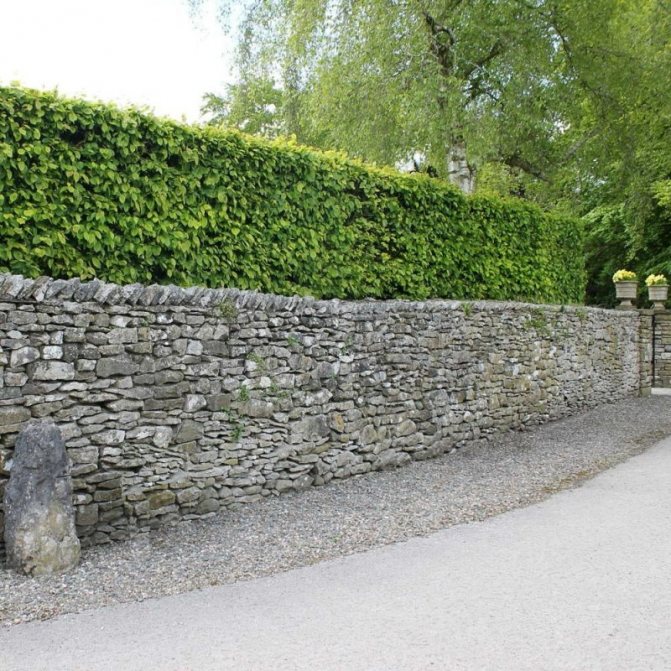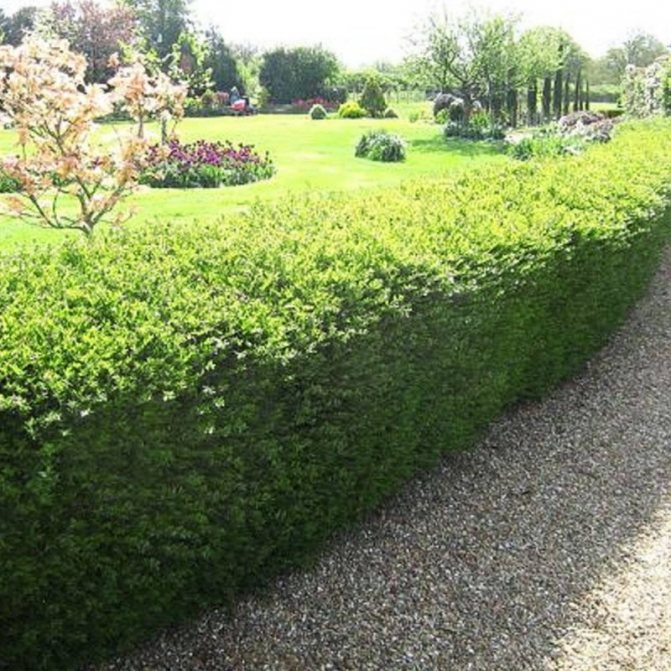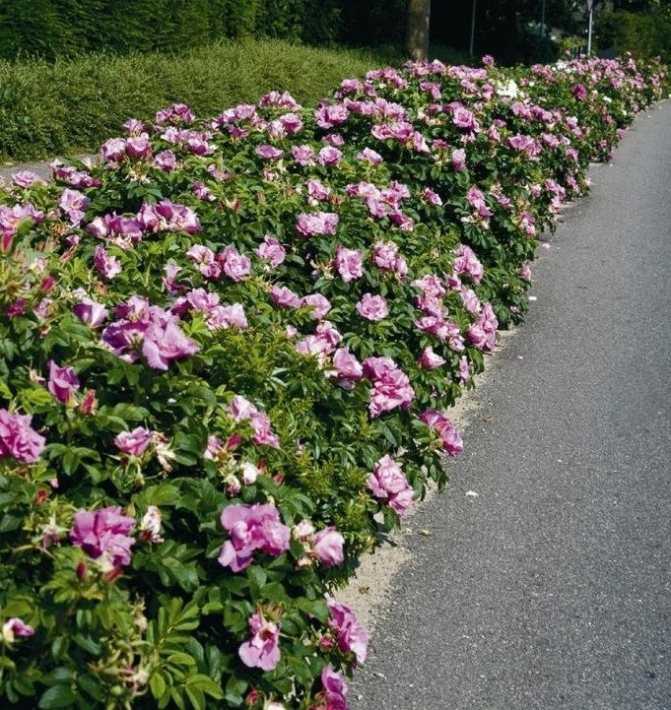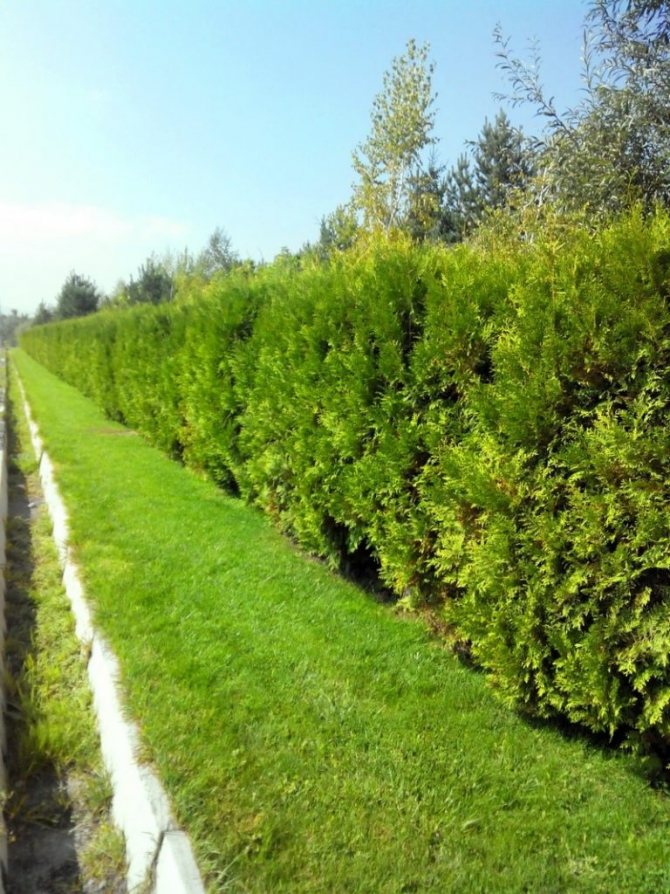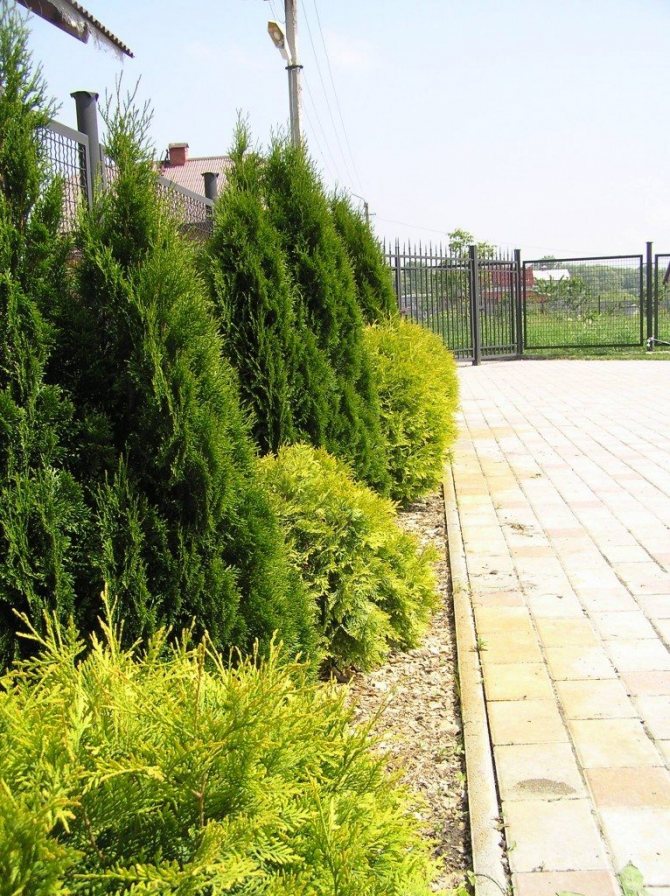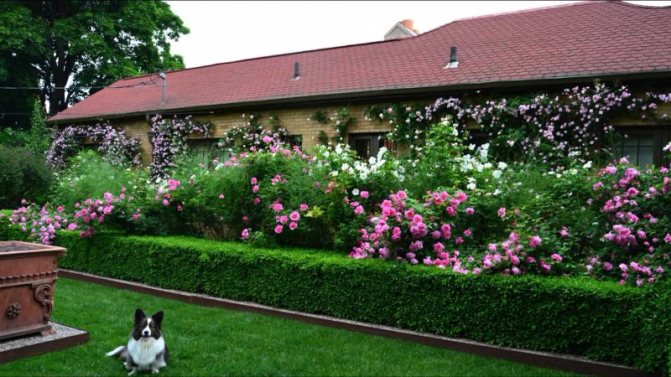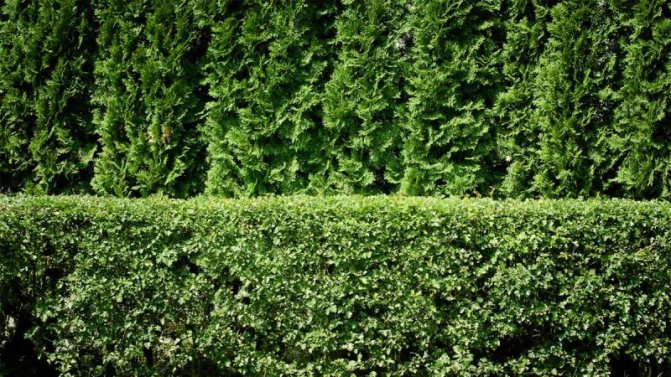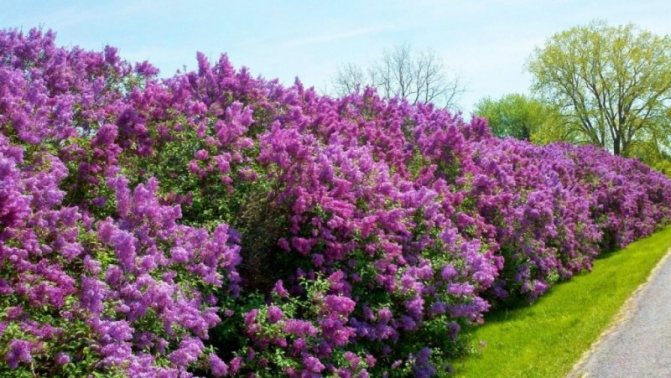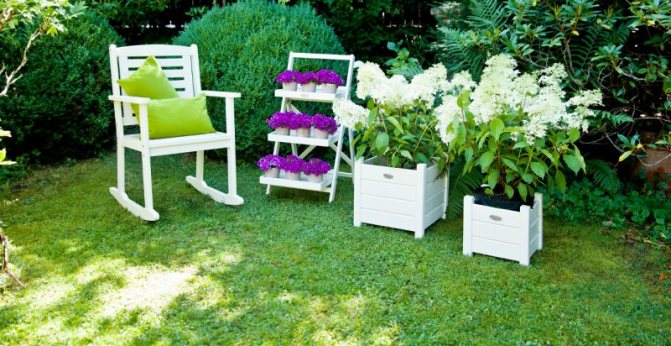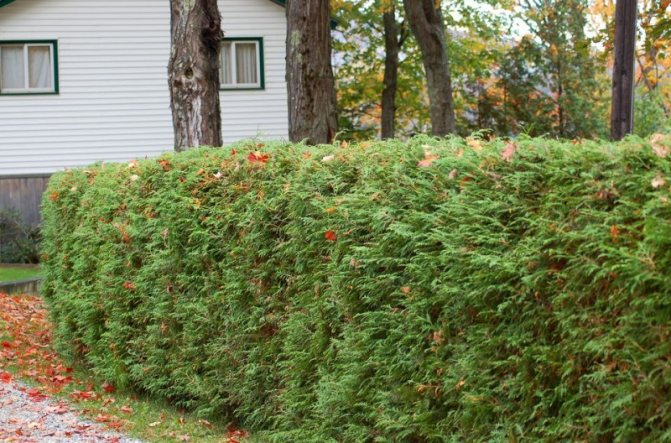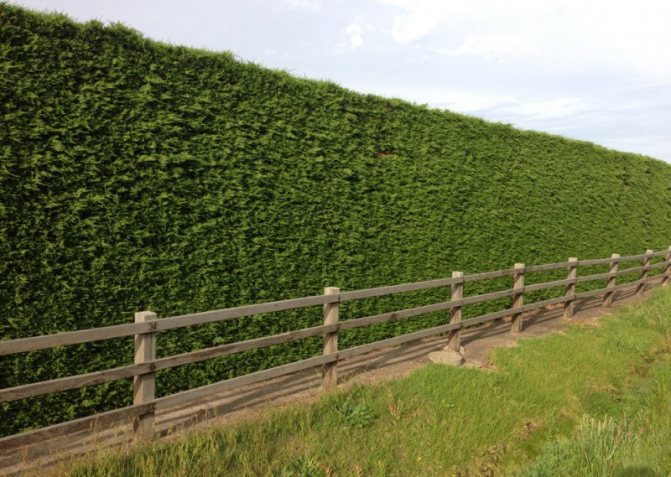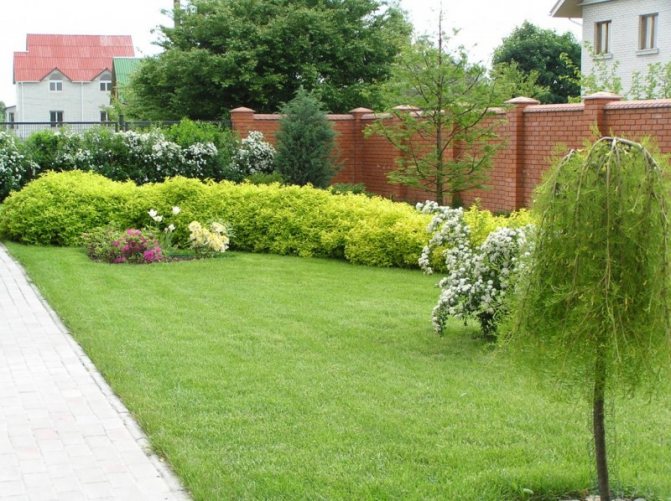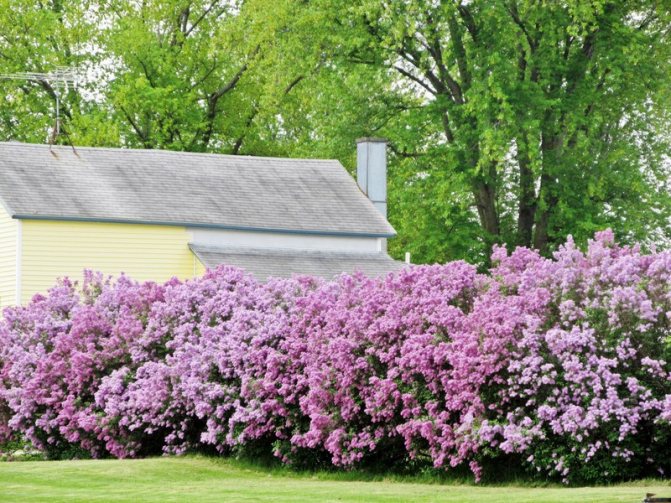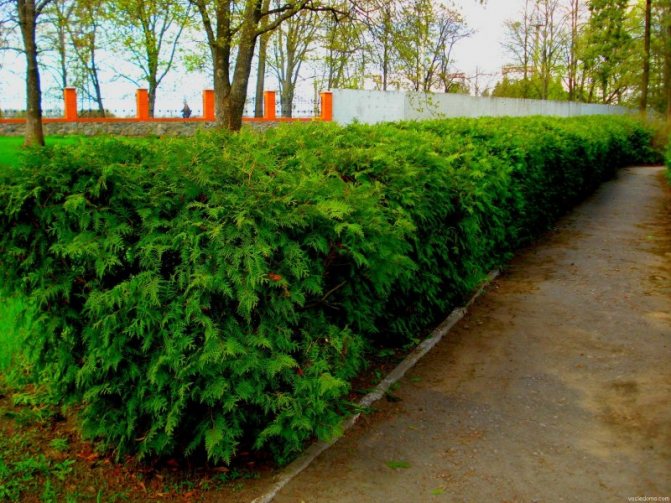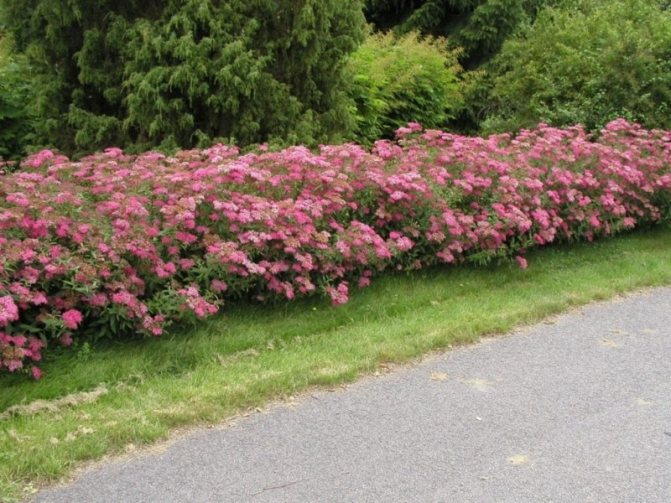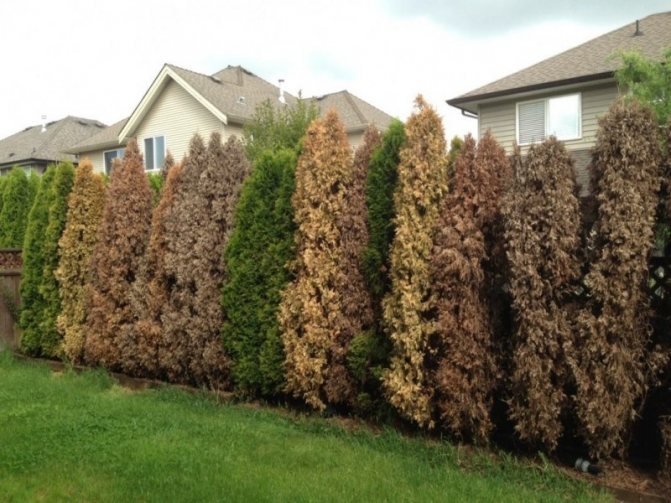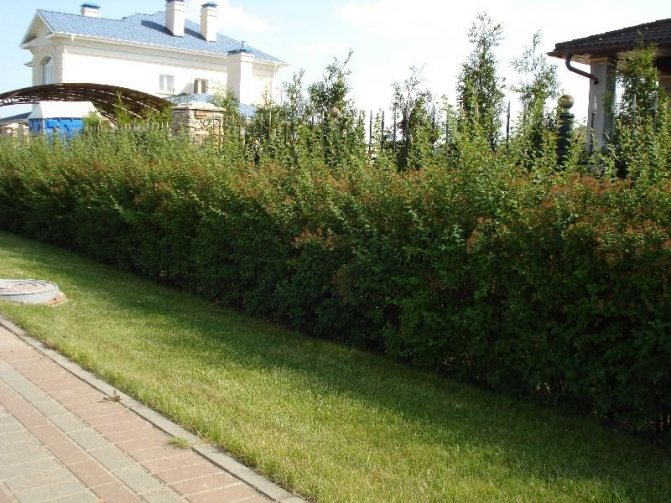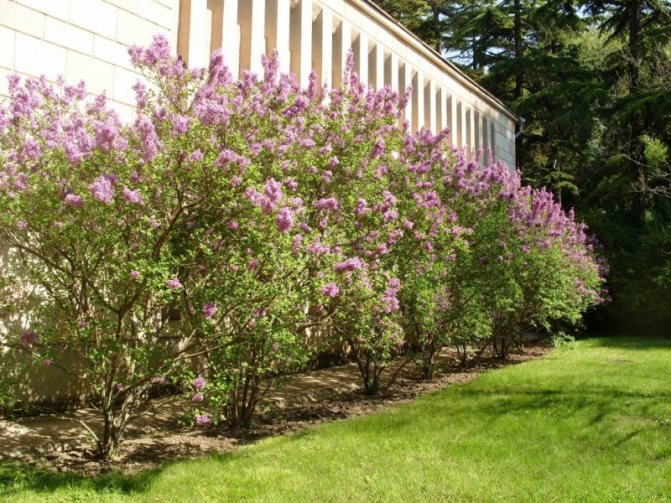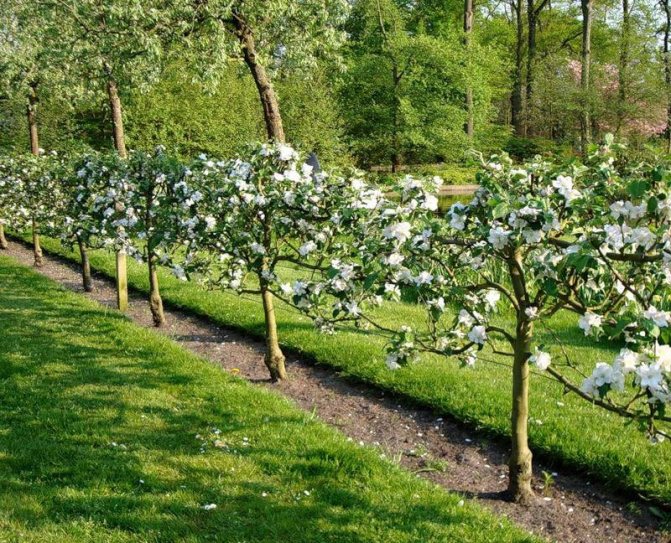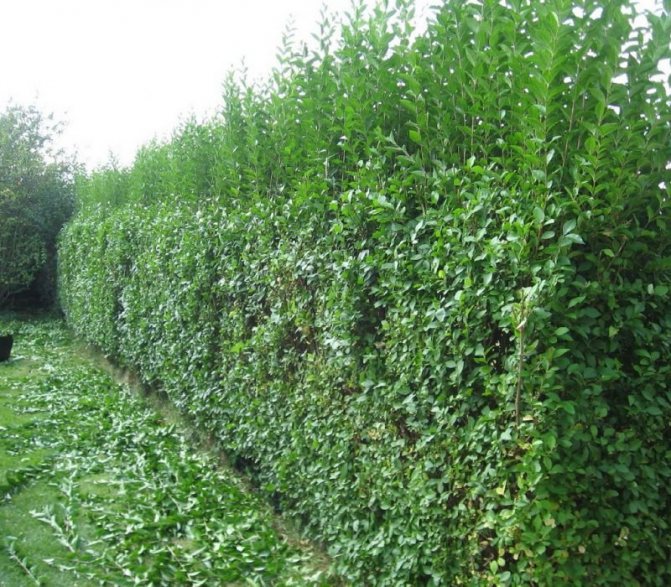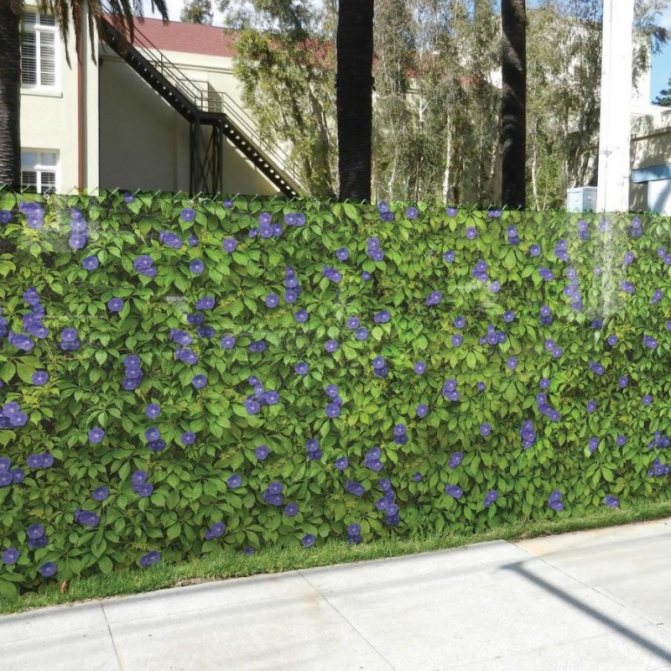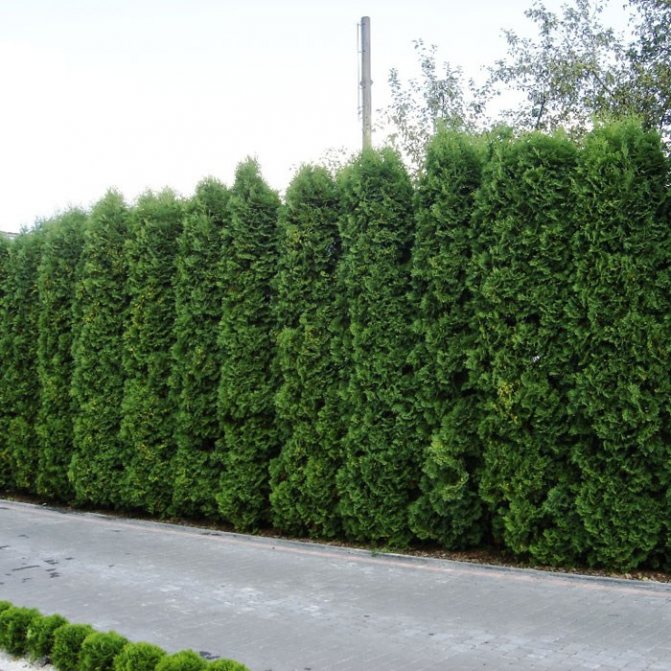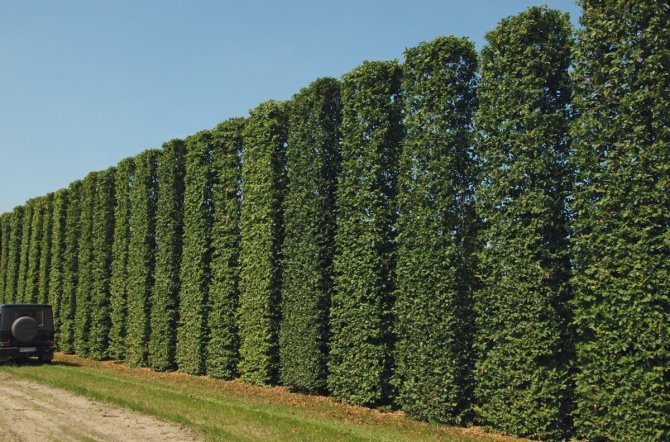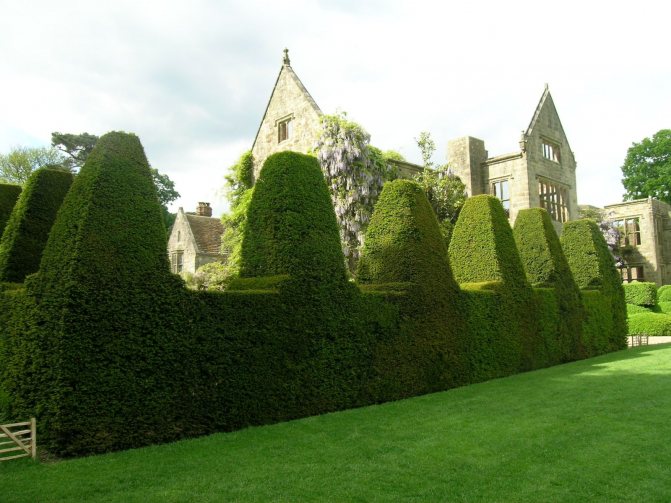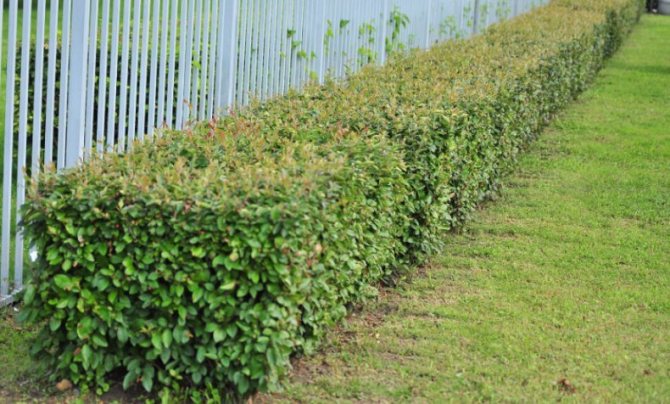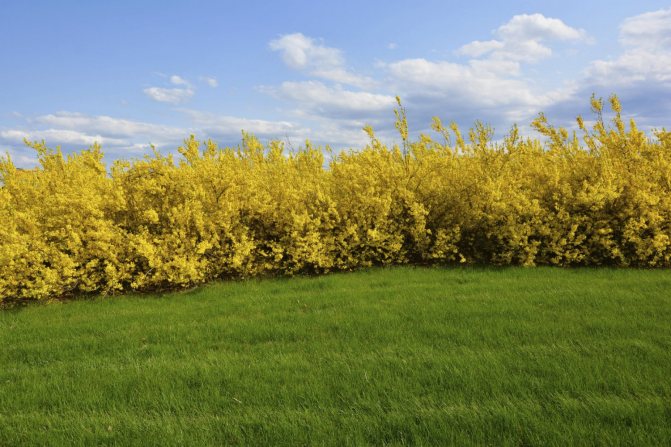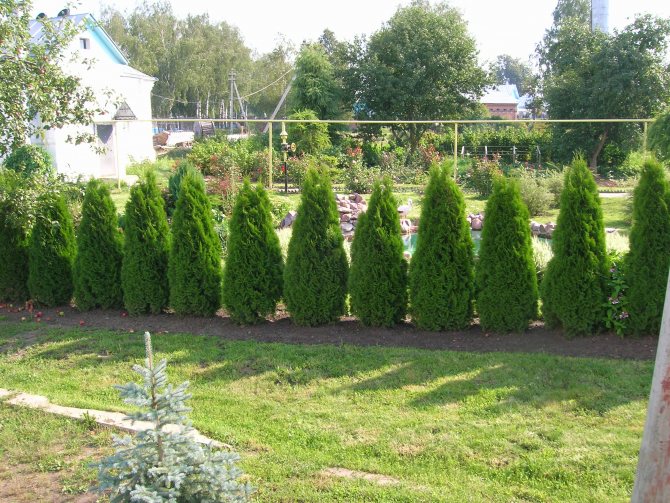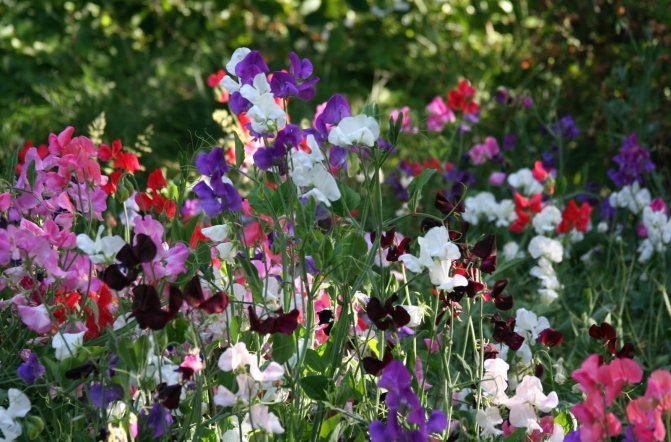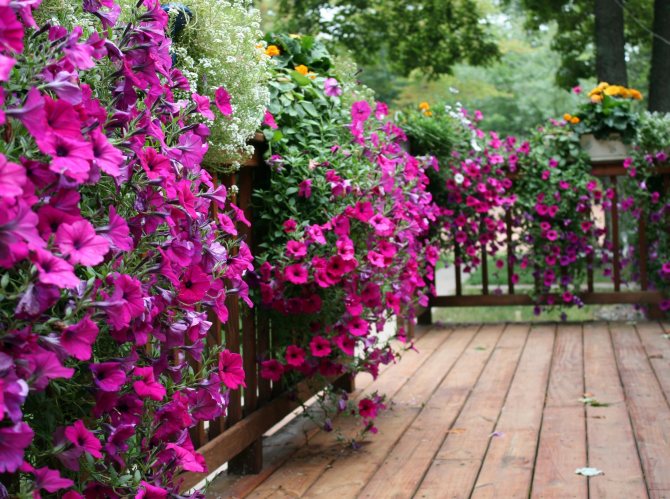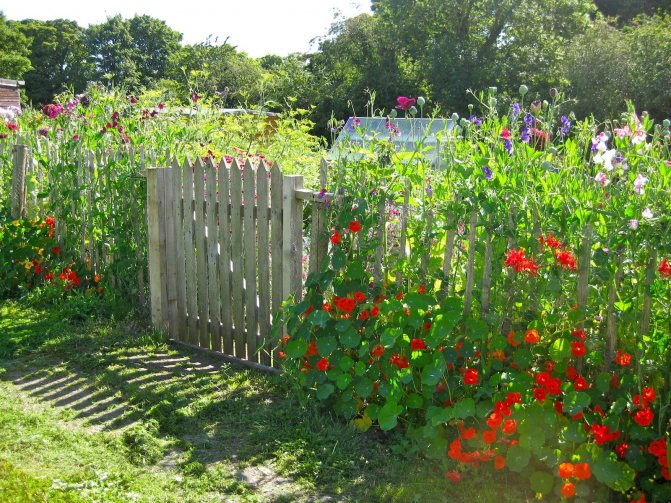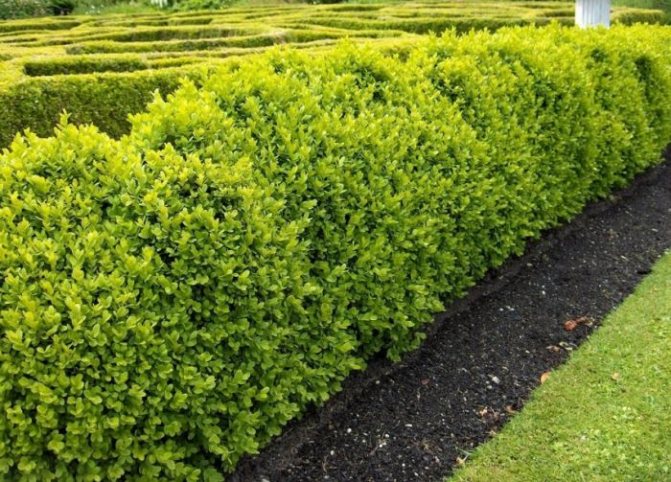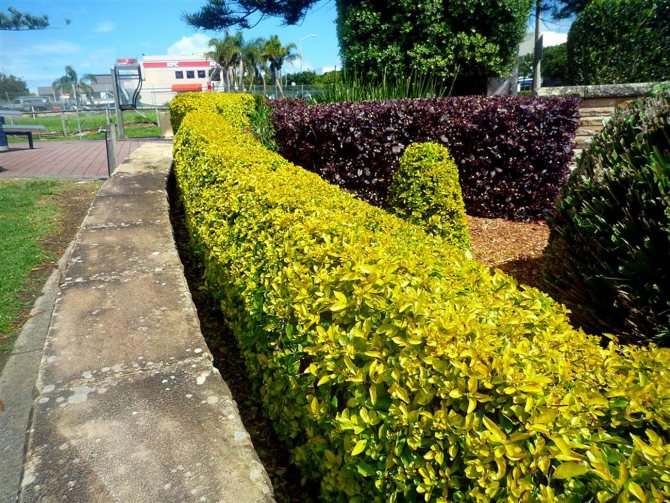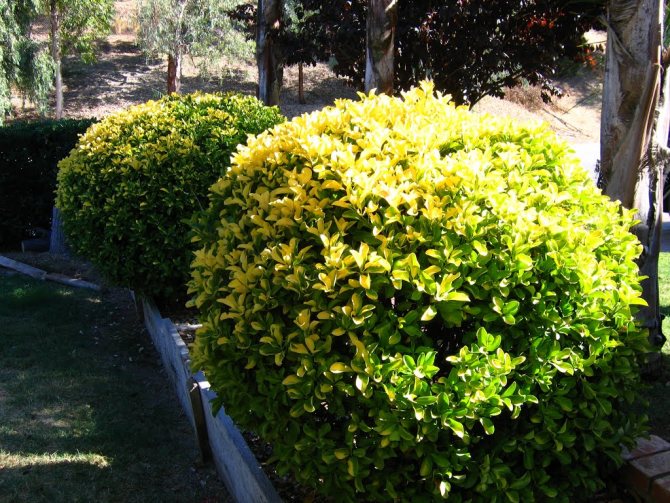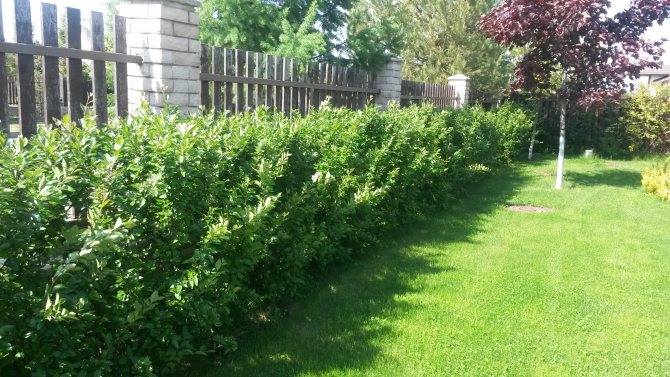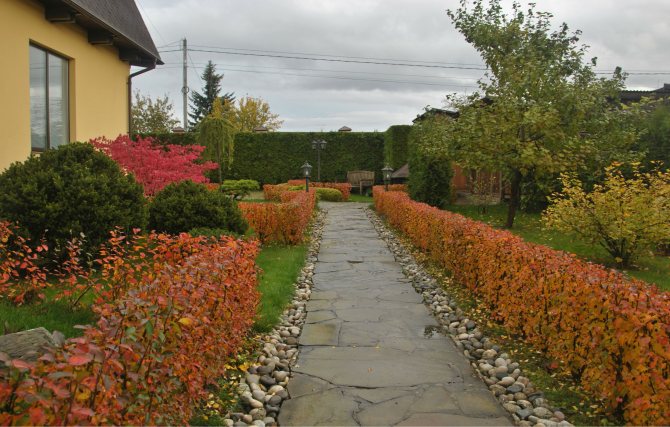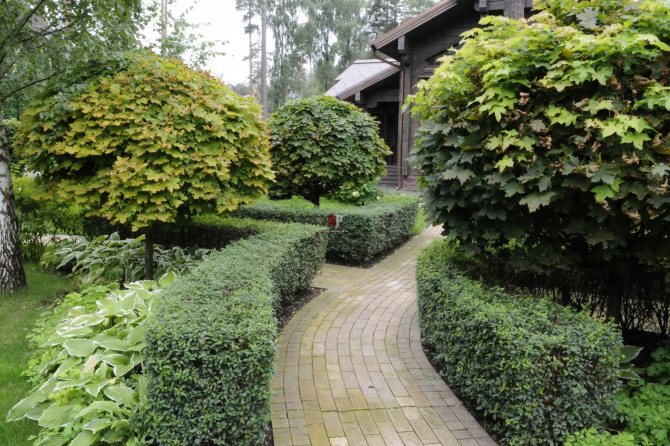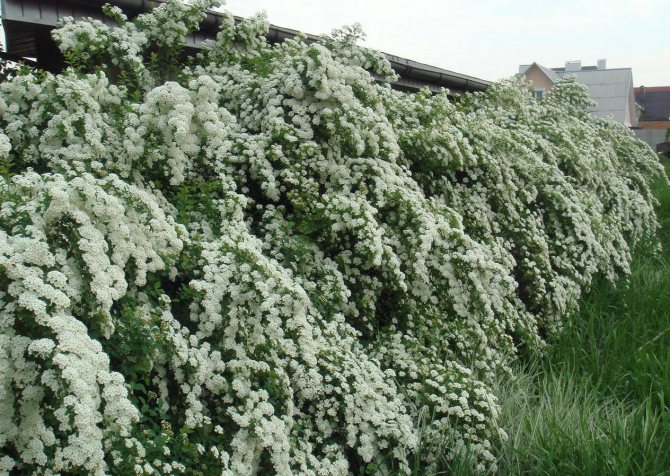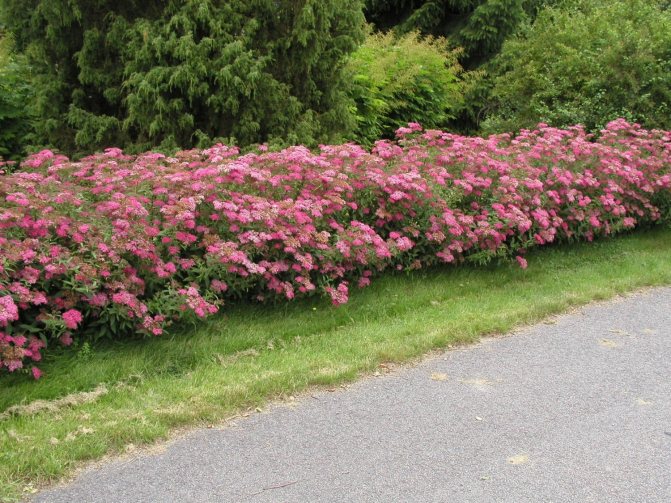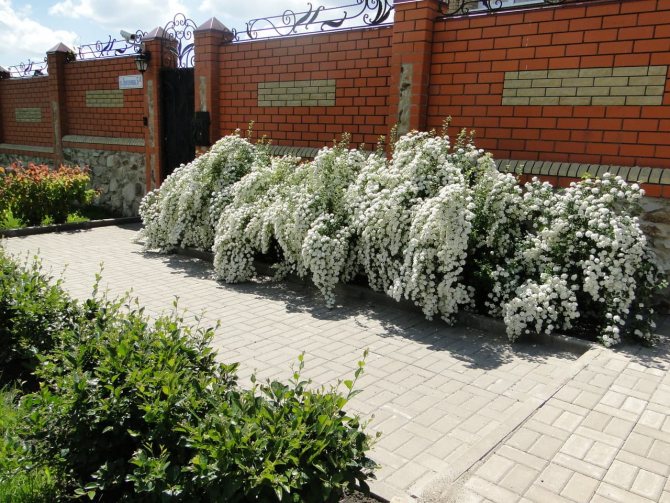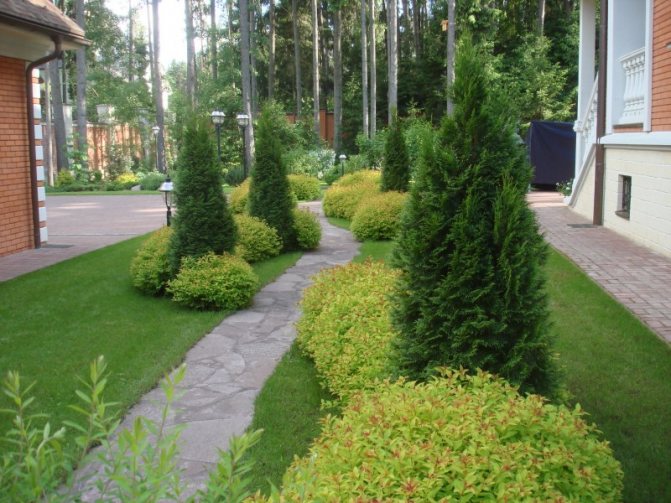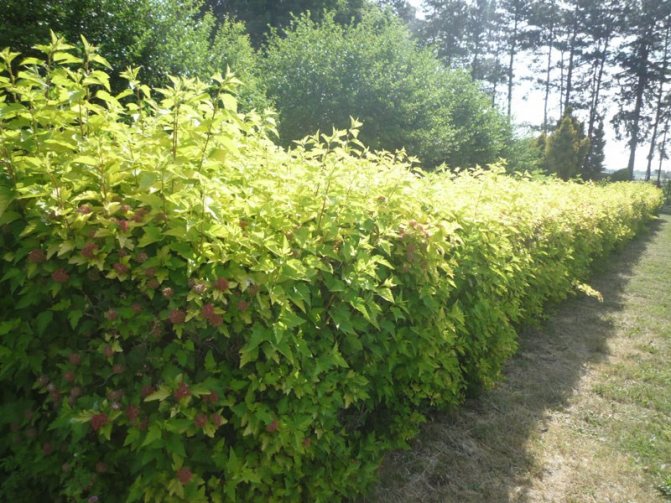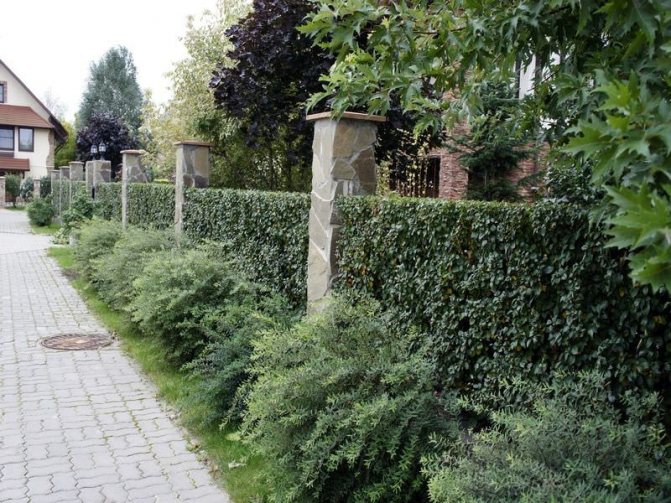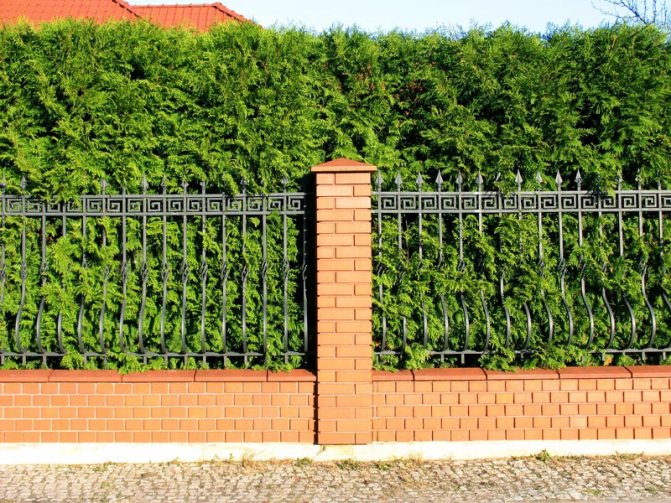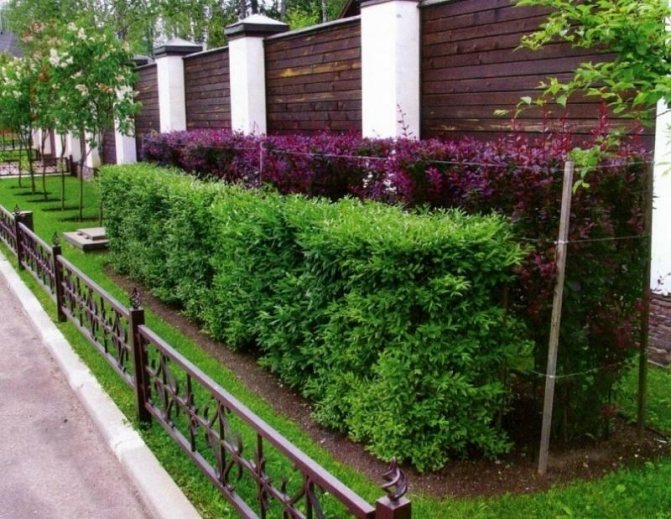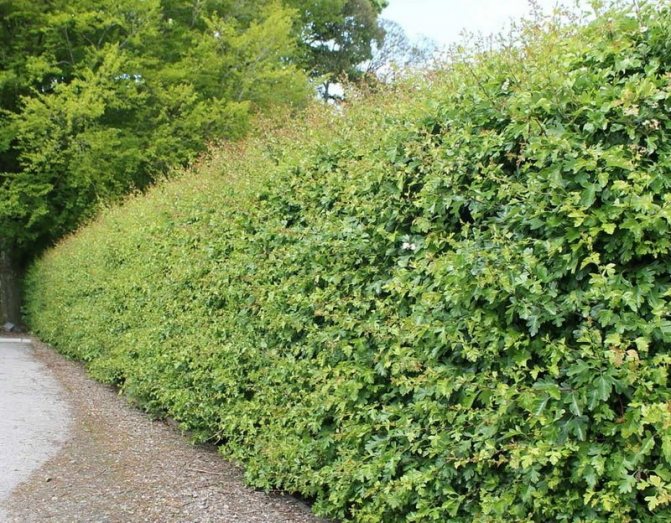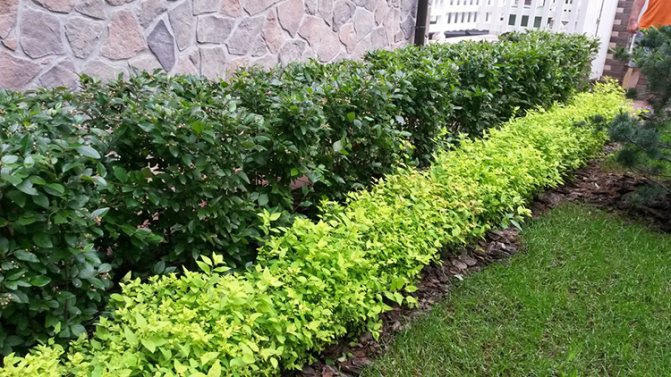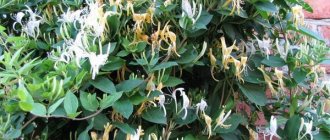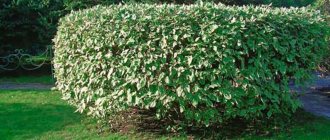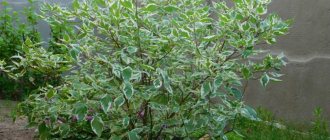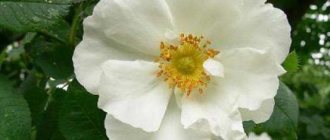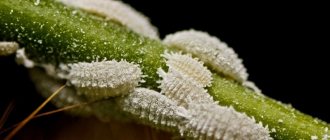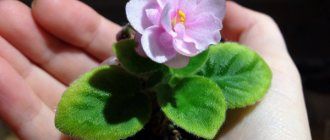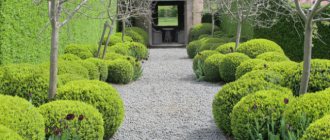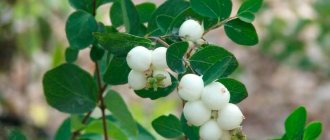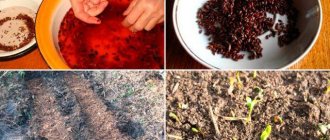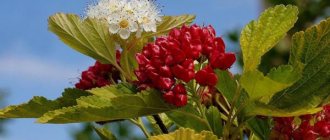We all have probably seen beautiful green fences that we would like to have on our site. What is a hedge? This is a kind of fence, which consists mainly of trees or small shrubs. Gardeners sometimes use herbaceous and climbing plants.
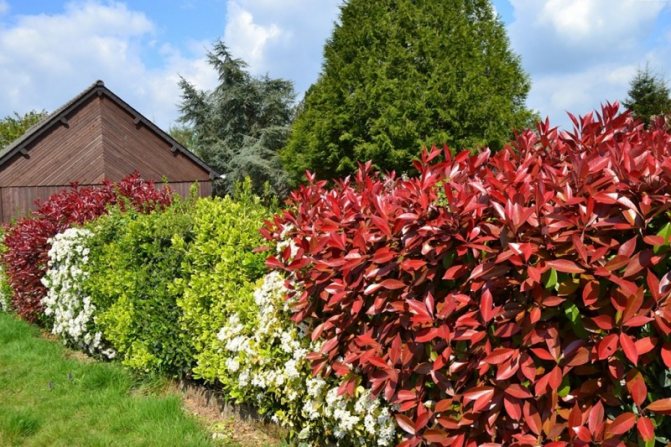
The purpose of such a fence is to enclose the territory. It can be either a private area or a public park. Such a hedge does a good job of protecting the garden from wind, dust, noise, and also from snow drifts in winter.
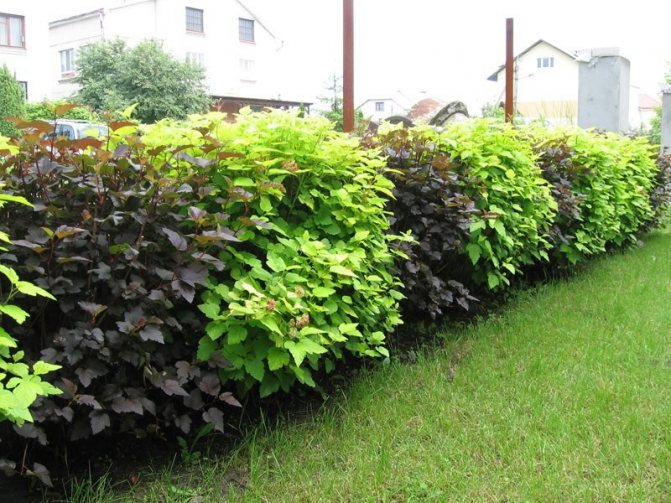

The advantages of such gardens include the ability to hide any error that you have on the site - an ugly fence, a small structure, you can emphasize the decorative planting that is already on the site.
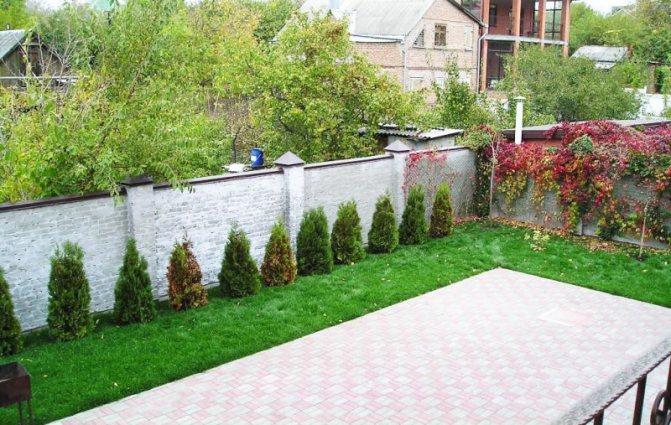

The disadvantages of hedges include the need for annual cutting and pruning of shrubs (these procedures must be done about two to three times a year), as well as the absorption of all nutrients from the soil by this fence. Thus, all plants that grow in the neighborhood may not receive additional nutrients.
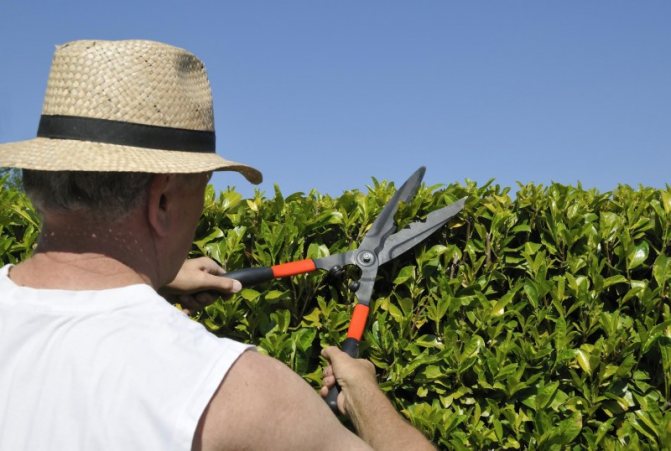

To prevent this from happening, do not forget to fertilize the green fences that grow next to the green fence of plants.
Popular types of deren
Derain white
Sprawling shrub with many root offspring that can be easily rooted. The leaves of the variety are whole, variegated - with a white border, in the fall the foliage acquires a reddish-purple hue. White dogwood blooms in June, small white flowers. The plant is shade-tolerant.
Deren Coase
View of a deren with large elliptical leaves, painted in dark green above, and below - in a greenish-bluish tint. In autumn, the leaves change color to a bright yellow color. Spreading shrub, the main branches of which form a long-tiered lush crown. Derain Kouza blooms at the end of May with beautiful yellow-green flowers with 4 white bracts, up to 10 cm in diameter. After flowering, in the fall, scarlet edible berries are formed, tart to the taste.
Derain red
Deciduous shrub up to 4 meters in height. It has a branched crown with drooping shoots that can be painted in various colors: from green to purple and red. The leaves of the shrub are rounded, bright green in color, have small hairs on the surface, below the color of the leaves is paler. In autumn, the foliage turns blood red, hence the red deren got its name. Inflorescences are corymbose, 7 cm in diameter, consist of small white flowers, of which there are up to 70 pieces. The flowering time of the variety is 15-20 days. In autumn, numerous small, black, pea-sized fruits appear.
Derain male or common dogwood
A shrub, and sometimes a tree with ovoid leaves of a light green color on top, and a paler shade below. It is a long-liver (lives up to 250 years), growing in the mountainous regions of the Crimea, the Caucasus, Europe and Asia Minor. It blooms with small yellow flowers with bracts that appear before the leaves. The flowering time is 15-20 days. After flowering, shiny fruits appear with a pleasant, slightly tart taste of red hues. The size of the fruit can be different (up to 3 cm in length).
Derain offspring
The shrub, reaching 2.5 meters in height, bears a resemblance to white turf. This species is characterized by hanging, red, shiny shoots that are easy to root. The leaves are green. It begins to bloom at the age of 4 years. Inflorescences with milky flowers 5 cm in diameter. Flowering time is May. The fruits are white with a blue tint.
Derain blooming
The species is common in the east of America. It has a spreading dense crown of green foliage, in autumn it is painted in red tones.
Photo of green fences
Derain variegated, varieties
The ornamental shrub of variegated dogwood has several varieties that differ in appearance.
Sort Elegantissima - leaves are concave, gray-gray, have a white edging around the edges.
Sibirica Variegata is a popular cultivar with bright red branches and flat green leaves with white edging.
Gouchaultii is a massive variety of variegated deren with leaves that have a wide yellow border, which becomes pinkish in the sun.
Cream Cracker is a graceful and attractive variety with leaves adorned with cream edging. The crown of the bush is directed upwards.
There are also compact and low-growing varieties of variegated deren with yellow-green branches, the height of the shrubs does not reach 1.5 meters.
Features of the design of the site with a hedge
The landing site is the outer perimeter of the site or a small area that needs to be made as private as possible.
The height of the structure can be very different:
- curb - landing with a height of less than 0.5 meters;
- low - 0.6-1.0 meters;
- medium - 1.1-1.5 meters;
- high - over 1.6 meters.
The most popular are combined fences, for the creation of which several species of plants are used, significantly differing in height.
There are also several types of landings:
- evergreen - they look beautiful all year round, practically unchanged;
- deciduous - lose foliage in autumn, look good in summer;
- blooming - have the maximum decorative effect during the flowering period;
- curly - capable of trailing, clinging to any support.
By arrangement, hedges are distinguished:
- homogeneous - consist of vegetation of the same species;
- trellis - consist of trees growing in a row, the branches of which are intertwined;
- combined - represent a complex multi-tiered landing.
According to the methods of care, free-growing plantings and molded ones are distinguished. The latter require constant cutting, giving them a certain geometric shape.
Choosing a place for planting variegated deer
Having made the decision to plant variegated grass in your area, it should be borne in mind that the plant grows remarkably and develops in any place: both in a sunny, well-lit area, and in partial shade. Varieties with bright leaves feel better on the sunny side; in the shade, the leaves will lose their variegated color and turn green. Considering that the plant is spreading and growing rapidly, it is undesirable to plant it near tall conifers and other shrubs. It is best to plant the plant in sandy or clay soils that allow water to pass through well. Loam and clay soils are undesirable for planting. The soil should be fertile and nutritious, as well as moist.
Best shrubs for the garden: bladder
Puzereplodnik has a characteristic "design" that distinguishes it from any other shrubs: first, its shoots rush up, and then picturesquely descend from top to bottom in smooth graceful arcs.
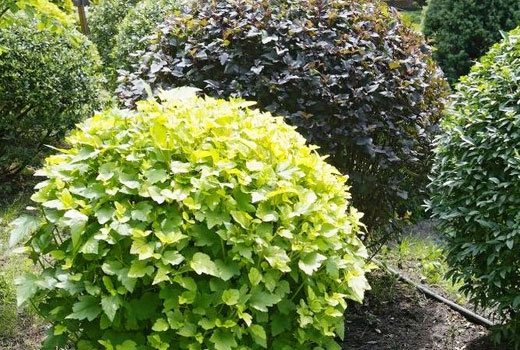

Pruning can help create interesting green shapes from the bubble.
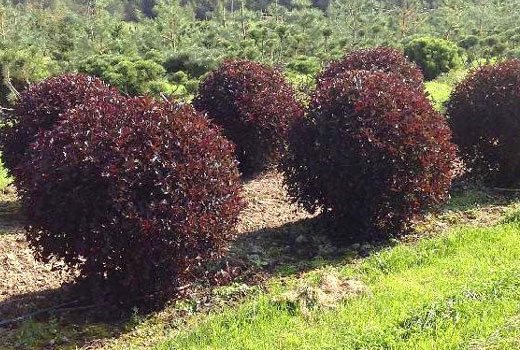

Beautiful color of the foliage of the vesicle
The nubble grows rapidly; under suitable conditions, its growth can be up to 1 m per year (an adult plant can have a height of 3.5-4 m). At the same time, it is rightly considered unpretentious: it perfectly takes root on almost any soil.In particular, the vesicle adapts to sandy soil and heavy clay.
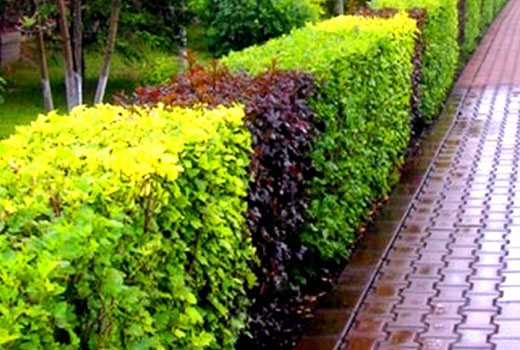

Bubble cage with green and burgundy foliage A hedge that frames the resting area. Bladder bushes.
The plant is sun-loving, but grows well in a small shade. But keep in mind: in a puzereplodnik with a colored color, in conditions of shade, the characteristic color disappears - the leaves turn green.
Flowers on a background of dark foliage
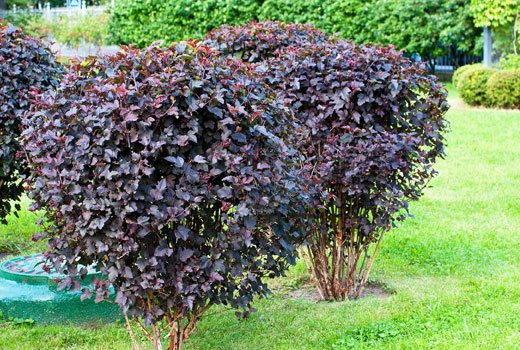

Bushes of medium height look good against the backdrop of greenery
If you plan to grow a dense hedge, place the seedlings at a distance of 20-25 cm from each other, a hedge with spreading bushes will work if you plant plants at a distance of 50-60 cm.It is better to propagate the bladder by autumn cuttings (ripe cuttings) - in this case, already in spring shoots will grow, and the plant can rise up to 1 m. Pruning is done often - up to 5 times per season. In the first 2-3 years, it is advisable to prune the plants as much as possible so that the lower part of the bushes is formed.
Planting variegated deren
Planting of variegated turf in a permanent place is carried out in the spring. Although the shrub is undemanding to the soil and special growing conditions, it tolerates frost well, it is still necessary to plant it when the air and soil are warm enough. So the young plant adapts faster, gets stronger and prepares for the upcoming cold weather.
The process of planting a seedling, some nuances should be taken into account:
- Organic fertilizers are added to a pre-prepared planting pit: compost or humus.
- If a swampy area or soil with high groundwater is selected for planting, then drainage is necessary.
- When purchasing a seedling for planting, choose a plant up to 4 years old.
- Seedlings with dried roots should be placed in a bucket of water for several hours so that the roots are saturated with moisture.
Landing
It is better to plant honeysuckle in the fall. Purchase, preferably, not one bush, but several (especially when it comes to edible varieties) in order to attract more pollinating insects.
There should be a distance of at least half a meter between the seedlings for hedges and one and a half meters for a separate planting.
You need to think about where to plant honeysuckle in advance, because the bush lives for about 35 years.
Edible blue fruit
It is important to consider several criteria:
- The soil. Honeysuckle does not grow well in acidic soil. To bring the acidity closer to the norm, the earth is lime;
- Humidity. The soil should not be dry or excessively wet. The main thing is that water does not collect at the rhizome;
- Shine. The plant tolerates shade, but it blooms better in sunny areas.
- Draft. The wind should not flutter the honeysuckle too much, otherwise the leaves, flowers, and fruits will be injured. In this regard, it is better to avoid the hills.
A living gazebo shrouded in honeysuckle
Small holes are dug for honeysuckle (40 * 40). Having diluted one glass of lime in a bucket of water, the pit is watered, covered and waited for 4-5 days. Then the bottom must be drained (broken brick or granular sand is excellent for these purposes).
Humus or compost (8-10 kg), double superphosphate (30-60 g), and also potassium salt (20-30 g) are added to 1 m 2 of soil.
The seedling is placed at a depth of 5-7 cm so that the root collar is at the surface level.
Freshly planted honeysuckle is watered and mulched with peat or manure.
As you can see, planting and caring for honeysuckle is not difficult, especially when the location is right.
Honeysuckle flowers with orange-pink petals
Transplant of an adult variegated deren
Transplanting an adult deren bush to a new place is stress for the plant. Therefore, it is recommended to transplant only as a last resort.
Reasons for a deren transplant:
- Inappropriate landing site selected.Planting a variegated grass seedling in the wrong place, for example, in the shade, can lead to the loss of decorative leaves. They will turn green. In order to return the decorativeness and beauty of the leaves, the bush will have to be transplanted to the sunny side of the site.
- Wrong soil selected. Derain prefers fertile and moist soils. On dry and poor soils, it will lose its attractiveness and stop growing.
- Unfortunate neighborhood. Derain grows quickly and occupies a large area on the site. This way he can drive out his neighbors. It remains to make a choice - to remove neighboring plants from the site, leaving the deren bush or transplant it to a more open place where it can grow quietly.
How to transplant a deren bush
It is better to replant mature shrubs in late autumn, when the plant has shed its leaves. This is less stressful for a deren, as it will have more time to acclimatize. If the transplant time is chosen - spring, then it should be done before the buds begin to swell.
A shrub with an earthy clod is transplanted, carefully so as not to damage the spreading root system. The border of the root system is determined by the outline of the crown. Dig in the root in a circle, with extreme caution. The dug out shrub is placed on a film, wrapping a lump from the ground in it, and delivered to a new planting site. The transplanted plant must be watered abundantly, and the soil must be mulched with humus.
Hedge transplant
To transplant a hedge, a planting trench is dug in advance. It should be 1.5-2 times larger than the root system of the transplanted shrubs. A layer of fertile nutritious soil mixed with humus, compost is poured at the bottom of the trench; it is recommended to add mineral fertilizers to the soil.
How to care for shrubs after transplanting
For active growth, the shrub needs regular watering. If the transplant was carried out in early spring, in the first days, shade the bush from the bright sun, since with increased evaporation of moisture, the shoots can dry out.
Advantages, disadvantages of a hedge
"Living" fencing has a number of positive and negative properties that should be considered before planning the creation of this type of green space.
Main advantages:
- a living fence is capable of keeping water in the ground. It protects the soil from draining by the winds, the snow in such an area melts a little more slowly, because the soil absorbs more moisture;
- the fence protects those on the site from street dust, filters harmful exhaust produced by vehicles;
- crops, young plants are mechanically protected from the winds - their leaves suffer less from breakage of stems, leaves, blowing off flowers, fruits;
- in the hot season, such barriers interfere with the rapid spread of fires in the fields, in the event of their local occurrence;
- a living fence protects from cold winds, prevents snow drifts on the paths;
- livestock finds a saving shade under it, protection from bad weather;
- birds often settle here, destroying insect pests of agricultural vegetation;
- woody, plant residues formed as a result of the thinning of the fence serve as fuel for the stove, fireplace, are used for the manufacture of handicrafts, for various household needs.
But there are also negative sides:
- ornamental hedge occupies a significant part of the usable area of the site, which could be used for growing vegetable crops;
- a high fence shades lower stands, takes away some of the nutrients from the soil;
- there are inevitable problems with digging the soil - near living fences, processing is done as carefully as possible so as not to damage the roots;
- if the snow in such places is not removed on time, part of the sowing will get wet, rot;
- additional paths are required for the removal of crops and waste from the site;
- in addition to useful fences, harmful birds settle in living fences, which destroy crops, damage crops, as well as rodents;
- correct crop rotation is also problematic.
A well-thought-out geometry of planting will save the owner from many problematic moments, emphasizing the beauty of the existing landscape.


Reproduction of variegated sod
Sodden propagation is carried out in 2 ways: slower - by seeds, and faster - by layering, seedlings and cuttings.
Seed propagation
This breeding method has a 100% successful result. Seeds should be taken from plants over 3 years old. Seeds are sown in the winter when the soil is sufficiently frozen. The seeds do not ripen at the same time. Before planting in spring, the seeds must be hardened for several months. For planting seeds, a substrate is prepared (sand, sawdust, moss), its volume should exceed the seed material by 3-4 times. It is necessary to layer the seeds with the substrate. Keep at a temperature of 5 degrees Celsius for 2 months. For each square meter of the plot, 5-14 seeds are sown to a depth of no more than 5 cm. The shrub will reach standard sizes only after 5-8 years. This method of reproduction is quite long and painstaking, rarely used by amateur gardeners.
Cuttings
Variegated sod is an ornamental plant and propagation by cuttings is recommended to preserve the characteristics and ornamental properties of the mother bush.
During the spring pruning of an adult bush, the shoots can be used as propagation material by cuttings. On a healthy strong cuttings there should be 7-9 developed buds. Cuttings are placed in a container with nutritious soil and placed in a greenhouse. During the summer, cuttings are fed with organic and mineral fertilizers and are well watered. In the fall, the seedlings will take root and will be ready for planting in open ground.
Dividing the bush
A well-grown deren bush can be planted by dividing the bush by dividing the root with young shoots. The division method is carried out in the spring. The mother bush is dug up, the root is freed from the ground. Then they are divided into parts with a sharp knife. The resulting young plants are transplanted into prepared planting pits, fertilized with a nutrient mixture.
Reproduction by layering
Derain variegated has a spreading crown with flowing shoots. To get a young plant by layering, shoots can be pinned to the ground with a metal bracket and sprinkled with earth. This breeding method is carried out in the spring. During the year, the shoot takes root well and is ready for transplanting in a new location next spring.
How to propagate honeysuckle?
Honeysuckle propagation is carried out by seeds, cuttings, layering and dividing the bush.
The roots are divided in the fall. To do this, the bush is dug up, disconnected as much as possible, based on the number of shoots, the number of parts, and the delenki are sent to the nursery, where a young bush is kept for 2-3 years. Sometimes it is immediately planted in a permanent place, but the first option is preferable.
Living arch above the entrance
Breeders who are in search of new varieties of plants are engaged in removing honeysuckle from seeds. Amateur gardeners do not practice this method.
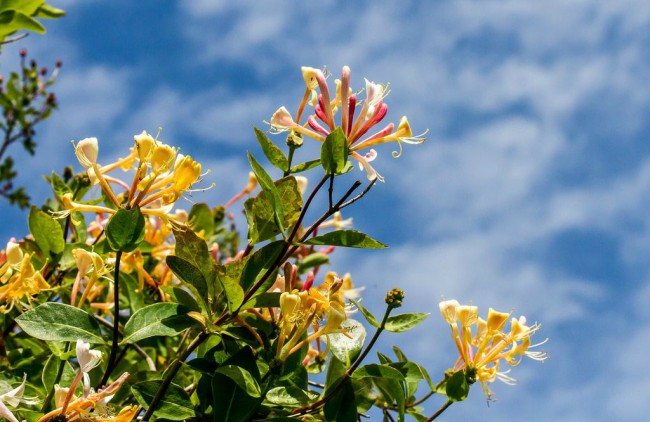

Honeysuckle against the sky
Propagation of honeysuckle by cuttings is the simplest and most popular method. Most often they resort to green cuttings. Its essence is as follows:
- On a summer June morning, the tops (12-15 cm) of young shoots are cut off;
- Leave two upper half-cut leaves, the remaining ones are removed;
- Make incisions under the kidneys;
- The twigs are tied, labeled with the variety if necessary, and immersed in a growth promoter (eg, indole butyric acid);
- Place the cuttings in a warm place under plastic wrap;
- The soil for planting should consist of drainage (pebbles or gravel), 20 cm of fertile soil and 10 cm of a mixture (1: 1) of peat and sand. Water it before use;
- The cuttings are lowered vertically, leaving 5 cm between adjacent shoots and 10 cm between rows;
- The planted cuttings are covered with foil and watered 9-10 times daily;
Caring for variegated grass
Derain variegated unpretentious in care, it perfectly tolerates drought, frost and adverse weather conditions. The basic rule of plant care is pruning and regular watering. The plant can be fed periodically. In the spring, mineral fertilizers are used (200 grams for each bush), and in the summer - organic fertilizers (5 grams of compost or chicken manure for a bush). If the bushes are used as a hedge, then it is recommended to trim them at least twice a year, in July and August.
Watering
Watering of young bushes is carried out regularly and moderately every day, adult bushes can be watered only on dry hot days, 2 times a week is enough. For each bush, 20 liters of water is enough. Excess moisture can lead to fungal infections. If the soil does not have time to dry out, the frequency of watering should be reduced. Watering decreases by autumn.
Temperature
Derain variegated normally grows and develops at a temperature of 15 - 20 ° C. It tolerates heat well, it is enough just to increase the watering of the bush. It is frost-resistant, there is no need for shelter for the winter.
Pruning
Regular pruning is a staple of plant maintenance. Derain lends itself well to pruning and from its crown you can create beautiful shrubs of a round shape. It is worth noting that the beauty of the deren lies in its unusual variegated foliage, therefore, when pruning, it is advisable to preserve its natural shape, only slightly correct it. When pruning, old, dry and diseased shoots, improperly growing branches, which interfere with the formation of the crown, are removed. Regular pruning is necessary. Pruning is not carried out in winter. After pruning, the shrub very quickly starts up new young shoots. If the shrub is used as a hedge, it is given a clear shape.
Care, haircut
To make the hedge as beautiful and presentable as possible, it needs constant care - timely watering, haircut, removal of dried parts, pest and disease control. The desired shape is given when the plants in it are still young. Pruning is done for the first time in winter and the second time at the end of summer. Conifers are pruned in late autumn, early spring.
During cutting, the growth of shoots increases, the crown becomes thicker. The hedge is cut, depending on the growth rate of its components, from one to four times a year. Each new pruning is done as close as possible to the previous one - this is how a high density of the bush is achieved, which does not sag over time, does not deform during heavy snowfalls.
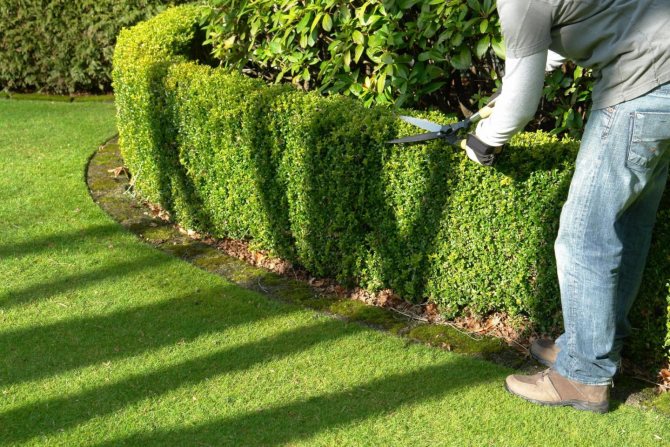

An overly neglected hedge is trimmed first on one side, and after a year on the other. At the same time, it is fertilized, watered, mulched. All types of trimming are made according to templates, high shears, standing on a bench, stairs.
The modern chemical industry offers a range of post-pruning treatments to inhibit the growth of new young shoots.
Diseases and pests of variegated turf
The shrub is not attractive to pests because of its unpleasant taste. Basically, variegated dogwood suffers from aphids, which can destroy the plant or spoil its decorative appearance. There are 2 ways to combat aphids:
- Mechanical. Pests are washed off with a stream of water from a hose. This method only partially eliminates aphids and is not effective.
- Chemical.Special preparations are used for spraying shrubs or the folk method (a solution of laundry soap).
Also, the lawn is susceptible to fungal diseases, in order to prevent them, it is necessary to temporarily stop watering and let the soil and roots dry out. When a fungal infection is infected, the diseased plant is treated with a foundation.
Barberry - "popular fence"
The thickened crown in combination with thorns perfectly obscures the view of your site from the street side. Different varieties of barberry have different leaf colors, and their combination will definitely decorate your territory. Red fruits are beneficial in cooking.
From the disadvantages of cultivation, one can single out the requirements for the soil, feeding and treatment from diseases and pests.
Derain variegated in landscape design
The shrub looks great both as a single bush and in a group with other types of deren. Due to its ability to change the color of the leaves, derain is often used in vibrant compositions. Low-growing shrubs look beautiful under the crowns of tall trees, creating spectacular compositions. The shrub adjoins remarkably with roses, juniper, barberry and Buldenezh viburnum.
Derain variegated is widely used for the creation of hedges, which requires regular molding and pruning. Derain grows quickly, therefore, without proper care, shrubs will turn into thickets of irregular shapes. If your summer cottage or garden needs a variegated and bright spot and decoration, be sure to plant variegated dogwood.
The variegated dogwood shrub is a wonderful garden culture, reproduction and care of which does not present any particular difficulties for novice gardeners. This unpretentious plant needs only minimal care: watering and pruning. Having given a little of his time and care, the derain will thank the owner with a magnificent view, beautiful shape and elegant variegated foliage and will become a decoration of the garden.
Creating a trellis fence
A fence on trellises, palmettes, cordons is a separate type of molded fence that requires regular pruning. The width of the structure does not exceed 10-25 cm, it is appropriate to do it along external fences, brick or wooden walls, forged supports, which are part of the garden design.
The most suitable plants for trellis structures are willow, raspberry, elm, hawthorn, lemongrass, apple tree, etc. Such a "flat garden" takes up a minimum of space, and the height can be from a 25-60-centimeter border to a real "living wall", more two meters "tall".
It is quite difficult to grow a trellis fence, and it will acquire an acceptable appearance at least in the third or fifth year of life. For planting, trees and bushes of low-growing varieties are used, the most acceptable method of placement is diagonal, mesh. Plants are fixed on a lattice, their shoots are crossed in several places, they are fused with each other by grafting. The distance between individual plants with such a planting is 20-30 cm, each of them, after sufficient rooting, is cut off 10-15 cm above ground level. The next year, when several shoots appear at the cut site, two of them are left to grow, removing the rest. When they grow up, they are crossed and tied with the processes of the "neighbors", cutting off over the place of bandaging. The next year, the two strongest shoots are again left, this is repeated for another two or three years, until the structure reaches the required height.
If you cut off the bark at the points of binding, pressing the branches of plants with slices to each other, they will grow together, forming a single plant organism that has many root systems, which is maximally resistant to external influences.
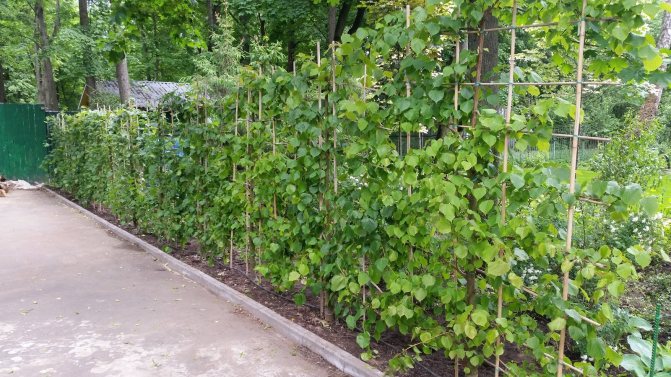

Derain variegated, photo
Sometimes you want to drastically change something on your suburban area - it can be a new building or painting of buildings, but the most effective is to create an unusual hedge, which is called a living fence.Today, the popularity of such fences is increasing with each new season, because it is a new, unusual and stylish framing.
The most popular type of plant for creating a hedge is turf. The main reason for the high interest is the ability to withstand severe frosts and temperature changes in the soil, which are characteristic of our climatic zone, since the plant's homeland is Siberia, meanwhile, green hedges made of deer can be seen in the gardens of Japan and China. A modern deren hedge is shown in the photo:
A hedge - derain - is the beauty, tenderness and tranquility of the owners, since this plant is very hardy to negative environmental factors. It is important to note that it lends itself well to care and retains an attractive look for a long period. The fence of the site looks like this:
The hedge made of white deer looks not only attractive, but also rich, it gives solidity and indicates the status of the person living in the house. It can be used to decorate hedges and fences on any type of soil - this is another plus of the plant.
Particularly popular is the elegantissim deer hedge, which is a deciduous shrub whose leaves are attractively colored - light silver and green.
Honeysuckle hedge
A hedge is indisputable adornment of any landscape. It looks great in city parks and private homesteads.
Honeysuckle green hedges are versatile because some shrubs are vines covered with beautiful flowers or fruits. They are used to decorate stair railings and other vertical structures located on the street. And some varieties, with proper pruning, resemble green curbs, which perfectly solve the issue of zoning the territory.
With the help of vines and traditional curb fences, it is possible to realize an original landscape solution.
Plant features
In addition to being hardy and outwardly unusual, the shrub can quickly grow on the site, forming not only hedges, but also places for summer gazebos and playgrounds. Derain is capable of reaching a height of more than 2.5 - 3 meters, which guarantees complete protection from prying eyes. In turn, the crown of the plant forms "caps", the diameter of which reaches 5 meters.
A hedge made of elegantissim deren looks very unusual in the autumn:
The main flowering period of this plant is late spring - early summer. It is important to note that deren shrubs live a long time - about a quarter of a century. White derain perfectly tolerates winter, is not afraid of severe frosts, therefore, special pre-winter care, as for other plants, is not required. Derain produces unusual fruits - small in size. For all its unpretentiousness to the conditions of detention, the plant does not like drought very much and can die, therefore watering is very important for it.
Climbing plants for hedges
Climbing annual vegetation for living fences has one significant drawback - it needs to be re-planted annually, to make supports so that the structure is even. Perennials are less of a hassle. She will not be able to protect the site from outside intrusion, but will only hide it from prying eyes. To create such a fence, sweet peas, honeysuckle, bougainvillea, cobea, nasturtium, morning glory bindweed, etc. are used. The main plus of planting: the decorative appearance appears quite quickly - in just a couple of months, it looks beautiful until the very frosts. Deciduous vines shed their "outfit" in late autumn, waking up in early spring.
Landscaping and possible diseases
The planting of deren with hedges in parks and alleys has long been practiced. Today this shrub is also loved by ordinary gardeners, so such eco-fences are not uncommon.The bush perfectly tolerates the obligatory haircut. Also, deren bushes can be easily applied in landscape design, used to create various compositions.
Planting is done in prepared soil - it should be soft and loose. The distance between shrubs, if several plants are supposed to be at least one meter. The plant tolerates light shading well. After planting, it is necessary to regularly water the turf. After the shrub reaches the age of 1 year, watering can only be carried out in the summer months and only in hot weather.
For many gardeners, the issue of fertilizers is relevant, since most plants use the substances that make up their composition, in the case of lawn, this stage can be avoided, since it absolutely does not need feeding. However, if the soil is still fertilized, the plant will grow faster. For this, it is better to use regular peat.
Particular attention should be paid to weeding in the first time after planting, since weeds can significantly slow down the growth of the seedling, therefore the stage of weed removal should become a regular work of the gardener. Mulching will not be superfluous, since it helps well to retain natural moisture in the ground, and also helps to quickly get rid of weeds.
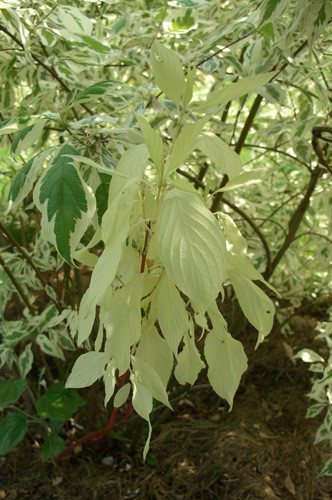

Until the age of 3 years, branches can not be cut - after this process should become annual in order to maintain the desired shape and give the plant a beautiful appearance. Dry and old branches are usually cut, as well as those that protrude outward from the overall composition. Also pruning is done to activate the branching intensity in the lower part of the tree.
Derain white is beautiful in all seasons. In summer, its lush, spreading crown is adorned with white and creamy fluffy flowers; in autumn, clusters of white, black or reddish-gray fruits appear against the background of bright green, purple and orange foliage. And even in winter, surrounded by snow, coral-red, bright green or yellow bark of the bush looks great. That is why the white turf hedge is so loved by gardeners and adorns many summer cottages.
Plant selection: fast growing trees, green fence shrubs
Many types of fast-growing trees and shrubs are used to create hedges, such as thuja, barberry, boxwood, thorns, dwarf spruce, honeysuckle, heather, rowan, lilac, hornbeam, irga, ivy, mulberry and many others.
Barberry
A beautiful, reliable, thick and thorny wall is obtained from barberry, through which even a cat cannot crawl. Due to its dense, deep root system, it is often used to strengthen slopes. Barberry is actively growing, therefore it is important to remove all unnecessary seedlings immediately after detection, it is often damaged by powdery mildew, rust, therefore disease prevention is required. The main varieties used: Amur, ordinary, Thunberg barberry. The fruits of most species are edible.
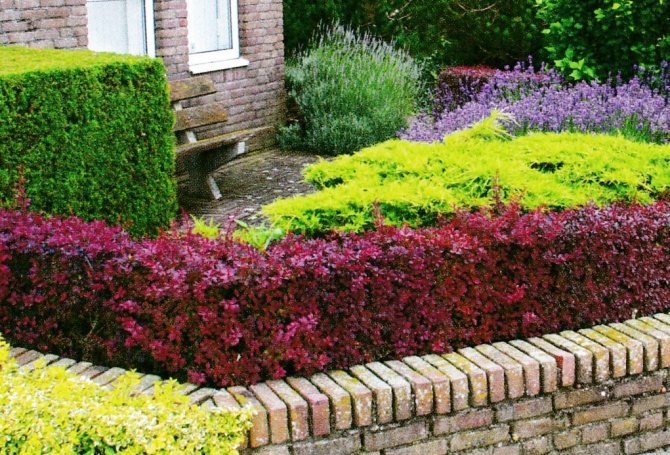

Periwinkle
Periwinkle is a curly evergreen dwarf shrub. With its help, "green walls" are obtained with a height of more than one and a half meters. The plant is distinguished by its amazing vitality - it is not afraid of frost, it feels great even on nutrient-poor lands, it tolerates the dry season well, it can grow both in sunny places and in the shade. To create a hedge, you will need trellises; in the first year of life, the seedlings should be covered for the winter so that the young roots do not freeze.
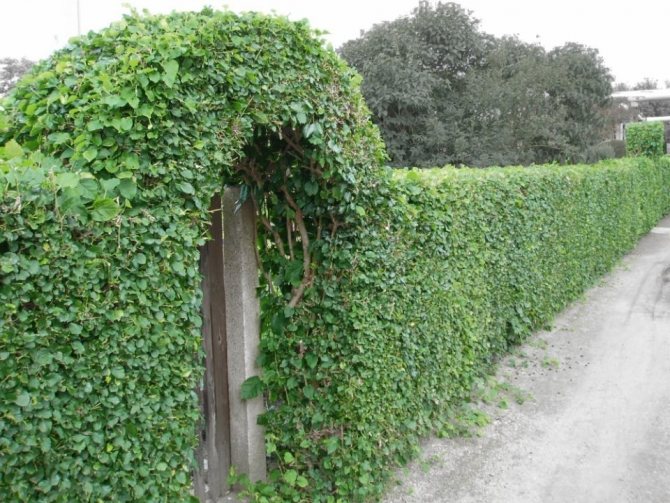

Euonymus
The spindle tree has many varieties, but the curly varieties are the most commonly used. The plant is poisonous, which should be considered if there are small children in the family. It is advisable to use rubber gloves during planting. Variegated species of euonymus are planted on the sunny side, varieties with white, yellow foliage - in the shade, since the leaves are capable of fading.The seedlings are rooted, covered with a film, supports will be required to create a fence, pruning is done in late winter - early spring. Popular varieties: Fortune euonymus - harlequin, blondie.
Privet
A living fence made of privet or "wolfberry" combines beauty and functionality, being a close relative of lilacs. It grows rapidly, especially after pruning, forms impenetrable thickets, up to three meters high. Privet is often used to form not only walls, but also whole sculptural compositions of the most bizarre forms. Plants are planted as close to each other as possible, preferably in a well-lit place on all sides, on soils that have good drainage. Before planting, manure and other organic matter are placed in the trench.
Hawthorn
Hawthorn is a deciduous shrub with many trunks, an excellent melliferous plant with edible fruits. It is unpretentious - it tolerates frost, prolonged drought and shade well. Hawthorn wood is very plastic, which allows you to form all kinds of shapes from its branches. In summer, the plant is covered with green leaves, which acquire a red-orange hue by autumn, fruits of many species are used for food, serve as raw materials for medicines. Common species: common, black, monopest, Siberian.
Heather
Heather is a low melliferous shrub with narrow leaves of green, silver, red-orange colors. The plant blooms in early August, but the flowers themselves remain dry until winter. Heather is able to grow on the poorest soils, but for lush flowering, preservation of high decorativeness, it is advisable to fertilize the earth. This plant is low, therefore it is used only to create borders, it is recommended to plant it in early spring, it can be grown by seedlings, layering, dividing the rhizome or from seeds.
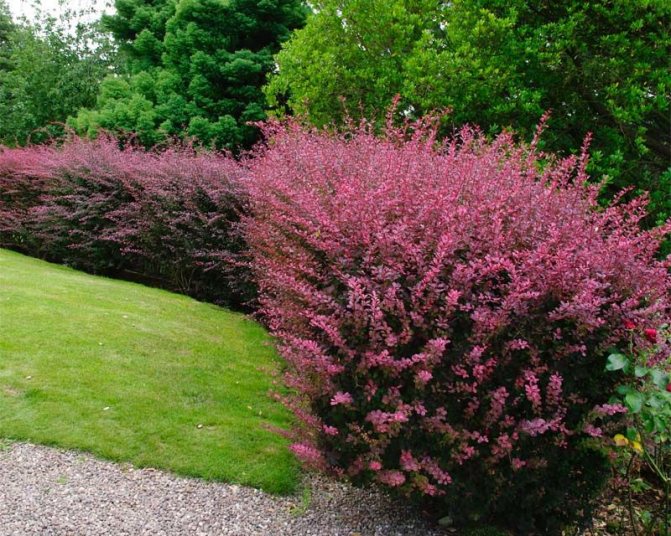

Hydrangea
Hydrangea is suitable for the formation of medium to low living walls. The plant prefers fertile soil, has large leaves, inflorescences. Treelike hydrangea is planted at the age of about two years, it requires regular watering, especially during the dry season, frequent fertilization during budding. Pruning is also done several times over the summer, and every two to three years - thinning, removal of the oldest shoots. Dried buds can be cut or left as a winter garden decoration.
Action
Deutzia is a richly flowering, but practically odorless plant. The fence comes out of it very graceful, but high - up to three or four meters. The action is unpretentious - it perfectly tolerates the polluted city air, but abundant flowering will be only in loose, nutritious soil, in a well-lit place. The plant is afraid of the cold, but quickly recovers with partial freezing. All varieties are suitable for living walls, but especially Lemoine's action, rough, graceful, less often Amur, small-colored. Bookmarking is done in spring, planting each plant in a separate hole.
Spruce
Live spruce is a very popular evergreen for garden hedges. It can be varied in height - both low-growing varieties and ordinary ones are used. They are usually planted on the north side to protect the garden from cold winds, with little or no shading. Spruce grows slowly, but always looks fresh. Its shades are green, blue, golden yellow, if you plant such plants in a certain order, you get an amazingly beautiful composition. The spruce fence protects well from prying eyes, with high-quality, timely pruning, it looks aesthetically pleasing all year round.
Irga
Irga is a plant belonging to the apple subfamily, but its fruits are berries. Irgi roots penetrate deeply into the soil, therefore no drought is terrible for it. Some species have significant frost resistance, bloom profusely, very beautifully. Irgi berries have a cinnamon flavor, and the plant itself, due to the root processes, forms a dense wall in the second or third year.Planting is carried out in late autumn or spring, at first abundant watering is required, and later - a garter, since the branches often bend under the weight of ripe berries.
Honeysuckle honeysuckle
The honeysuckle variety honeysuckle perfectly withstands frosts, reaching more than five meters in height, is an abundant honey plant. The plant thrives on moist soils, sunny places, it has dense foliage and tasty berries. Seedlings are first grown at home in flowerpots, in spring or autumn they are planted in open ground. When planting, you should install strong supports for the fence - they are made of wood or metals, a hedge can also rest on a regular fence. A finished hedge requires painstaking care - regular haircut to shape, watering, fertilizing.
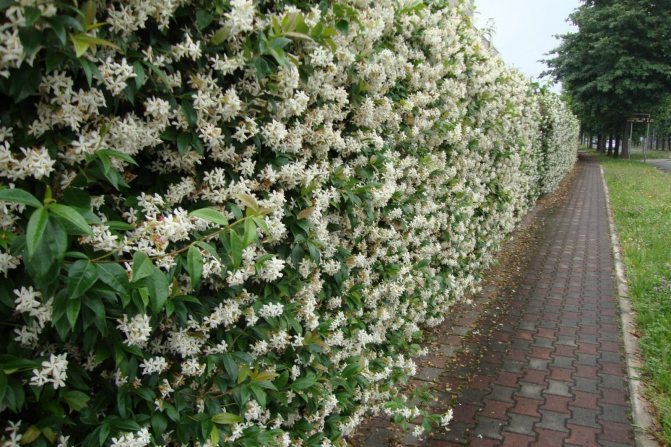

Willow
A living willow fence looks very elegant, the tree grows quickly, after three years it forms a full-fledged high wall. Willow is frost-resistant, there are about 600 species of it, but the most commonly used are holly, silver, Babylonian, purple, Hakuro Nishiki. Planting is carried out from early spring to late autumn, sunny places are preferred, fertilization is not necessary, but abundant watering in the first year of life is important. The seedlings are placed at an angle of 45 degrees, fixed with props, rods. It is recommended to bind, tying crosswise, one year after planting.
Large-flowered campsis
Campsis or tube flowers is a perennial flowering deciduous vine. The plant is unpretentious, frost-resistant, but loves warmth and light, blooms from June to the end of September. Campsis grows extremely quickly, therefore it is important to prune it in time, direct the shoots in the right direction, remove old branches, freeing up space for new ones. The plant is often used in mixed plantings, planting other low-growing perennials in the foreground, which cover the base of the vines. In the first year, the vine grows more than a meter.
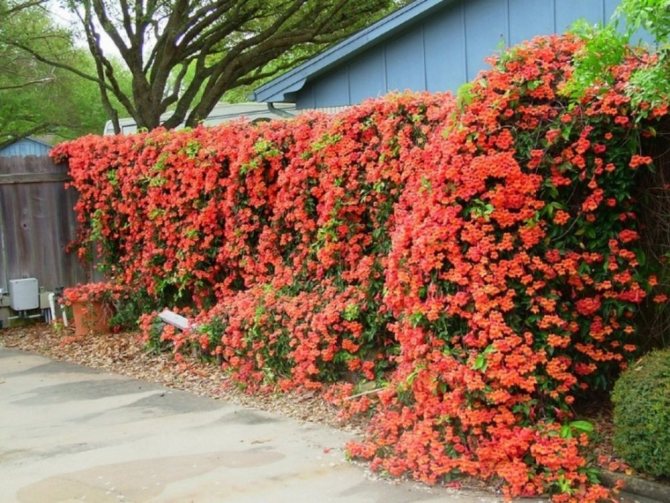

Cotoneaster
The cotoneaster is divided into two varieties: deciduous and evergreen. The most often grown cotoneaster is brilliant - it is planted in partial shade, on sandy soil, in which there is no stagnation of moisture. The plant is used to create walls 1-1.8 meters high, borders and islets up to 60-80 cm in height. It is recommended to plant a cotoneaster in a maximum of one or two rows. Planting specimens with open roots is carried out in the spring, before bud break or after the leaves fall, just before the frost. Plants with a closed root system can be planted from early spring to late summer.
Lawson's cypress
Lawson's cypress belongs to the cypress family, has scaly needles, falling shoots, a cone-shaped crown, and a developed root system. The evergreen plant perfectly adapts to unfavorable urban conditions, poor soils, but with severe frosts, young shoots often freeze out, therefore, in the middle lane it should be covered with spruce branches. Cypress is recommended often, water abundantly, loosen the soil, prune in time. The plant is suitable for high walls, mixed plantings.
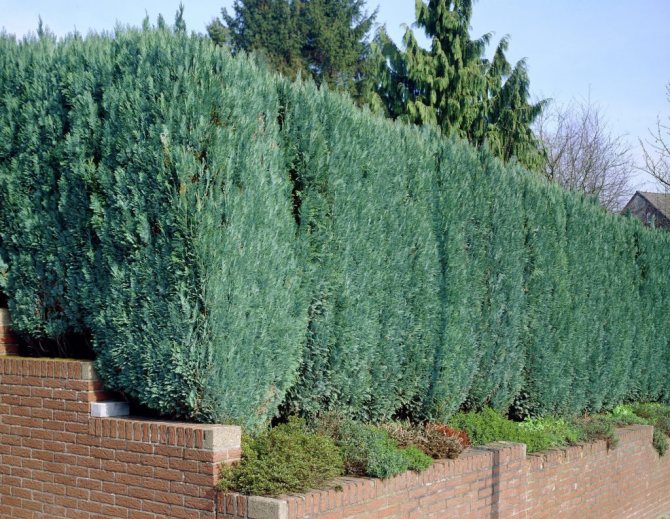

Cupressocyparis Leyland
Cupressocyparis Leylanda has an evergreen cone-shaped crown with hanging shoots. The plant can reach more than 27 meters in height, up to five in width a crown can grow. Seedlings are grown in flowerpots, and when their roots are sufficiently developed, they are planted in open ground. Cupressocyparis grows well in the shade, young trees require frequent watering, and for older ones, rain is enough. During the season, such a fence adds more than a meter in height, so pruning is necessary.
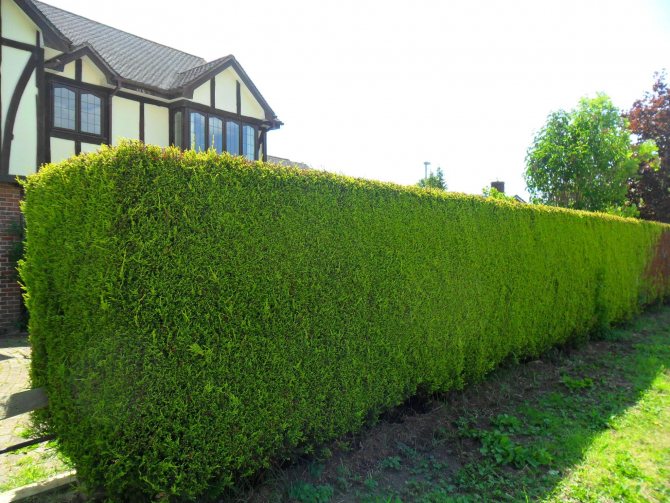

Laurel
Very beautiful barriers are obtained from cherry laurel - outwardly it looks like a ficus and laurel. All species, except for medicinal, grow extremely slowly, because the latter is often used.The plant has a high resistance to frost, shade, but requires a lot of water, in the long absence of which it stops blooming and bearing fruit. The first pruning is done at the end of summer, in the second year of planting life, after - twice a year. Some varieties give edible fruits, practically not damaged by parasites, diseases. Cherry laurel is not only cut, but also folded, wrapped around supports, nets.
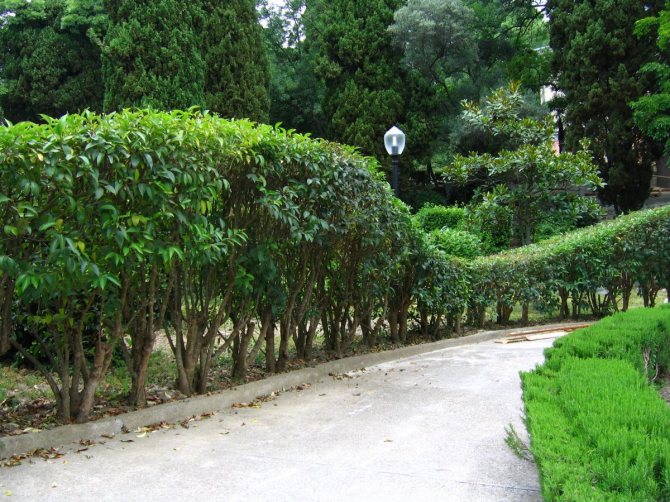

Shrub cinquefoil
Shrub cinquefoil or "Kuril tea" is suitable not only for creating garden decorations, but also for brewing tea infusion. The plant is very tenacious, unpretentious, frost-resistant, up to one and a half meters high. If properly cut, the shrub will remain very decorative all year round. Popular varieties: kobold, goldfinger, daydown, princess. The plant prefers light, fertile soil, planting in the ground is done when the seedlings are two years old, the surface of the soil is mulched with sawdust. Sanitary pruning is done in the spring.
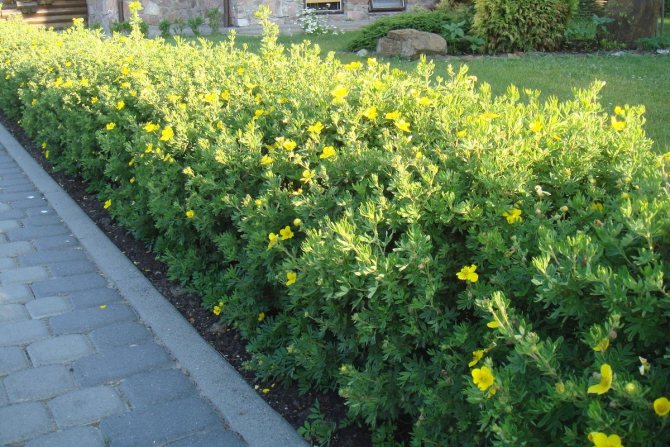

Magonia
Magonia forms a low loose fence, blooms beautifully, giving many tasty berries, is a fragrant honey plant. In summer, its leaves are green, by winter they become red-burgundy. The shrub is growing slowly, unpretentious, frost-hardy, drought-resistant, not afraid of pests. In hedges, it is most often combined with higher or lower plants. It is preferable to plant in the shade, pruning is done in the spring, but not necessarily annually. Varieties: Japanese, holly, creeping.
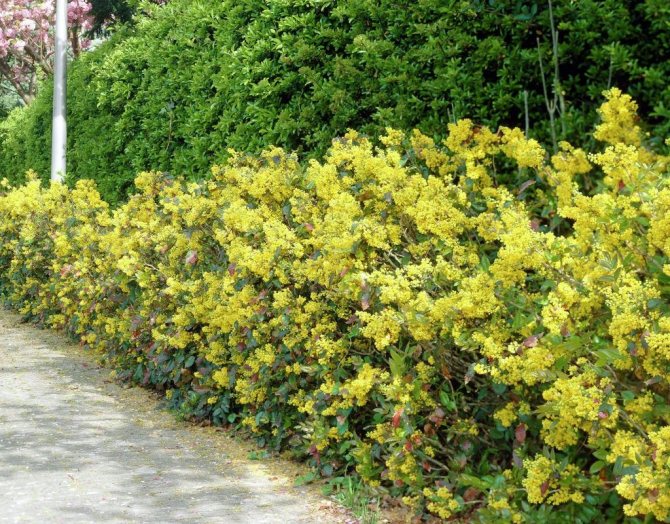

Juniper
Evergreen juniper creates luxurious barriers, bringing true forest scent to the site. It is great for trimmed hedges and blends well with hardwoods. The most common types: Chinese, scaly, Cossack, ordinary, Virginian. Different breeds grow from one and a half to 25 meters in height, their needles are green or bluish-gray. Most often, juniper is used to decorate large areas, it is unpretentious, but excessive stagnation of water can destroy the seedling. Planting is done in spring or autumn.


Holly
From the holly, a prickly, impenetrable, evergreen structure is obtained. The plant has dark shiny leaves, beautiful berries, grows well both in partial shade and in the sun. The planting is carried out in April or October, the hedge reaches its "adult" size in the fourth or fifth year of life. Most holly varieties are not suitable for extremely cold regions, as they freeze easily. This type of living fence slowly gains in growth, is damaged by flies, it is cut off once a year.
Balsam fir
The plant has a conical shape, soft needles, with a pleasant aroma, without cutting it can reach 23 or more meters in height. The formation of a hedge is made from seedlings at least five to seven years old, preferably in April or September. The ground around the young trunk is abundantly sprinkled with sawdust, covered with spruce branches, since in the first year after planting, fir trees often freeze out. It is better to plant in partial shade, choosing a well-drained, fertilized soil, preferably near any water bodies, but balsam fir does not tolerate stagnant water.
Garden ivy
A garden ivy fence is the most unpretentious design; even a novice gardener can grow it without any problems. The plant requires shelter in severe frosts, it is badly affected by the winds. Disembarkation is carried out in the spring, preferably at higher elevations. The first year ivy grows slowly, after that it grows a little faster. Frequent watering of ivy is not necessary - once a week is enough in a hot period, in a rainy period, you can not water at all. It is convenient to use ivy to decorate ugly garden buildings - fences, sheds, gazebos, etc.
Bubble
The most common cultivar is the viburnum bladder.It is a deciduous shrub up to three meters high, it is lush, very voluminous, has serrated leaves and "fluffy" fragrant inflorescences. Flowering, fruiting begins in a plant over four years old. In order for the color of the leaves to be uniform, the bladder is planted in sunny areas, away from fruit trees. The soil is preferred light, loose, well-drained, planting is carried out in May. The plant is well adapted to the polluted air of big cities, it filters it efficiently.
Rowan
Weeping, chokeberry is used to create hedges. The plant is unpretentious, tolerates frost and drought well, its berries are edible. Rowan is propagated by cuttings, planted in spring in a well-lit place. The haircut is done two or more times in the first year, less often in subsequent years; it will take at least three to four years to form the fence. Before planting, it is advisable to fertilize the soil well, the estimated contours of the future fence should be fixed with a frame made of sticks so that the shape comes out correct.
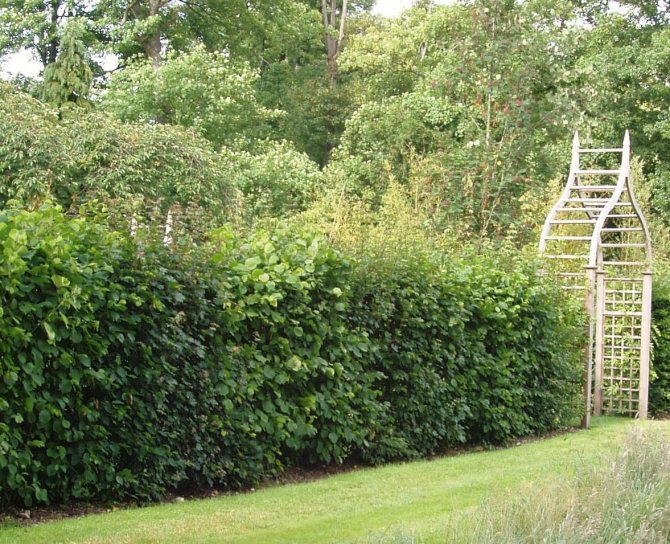

Lilac
Lilac is a versatile option for creating living fences; it grows rapidly in the spring and summer, decorating the garden with white, pink, purple, blue or purple flower clusters. Well-drained soil is preferable for lilacs, dwarf varieties are planted densely, larger ones a little less often. The older the plant, the more viable it is - seedlings older than two years are purchased for planting. The first haircut is done two years after planting, it is done in early spring or after flowering. The soil around the young specimens is sprinkled with sawdust so that the roots do not freeze.
Snowberry
Snowberry is an unpretentious plant with small white inedible berries that hang on branches even in winter. Some species have red or black berries, but they are rare in the middle lane. The snowberry is recommended as a non-forming hedge, reaching a height of 1.6 m. It is often used in mixed plantings with rowan and roses. Planting is carried out in pots, since in the open field the seedlings will have to wait a long time, in three years the plant reaches a height of one meter. Any, even lime, rocky soil is suitable for a snowberry.
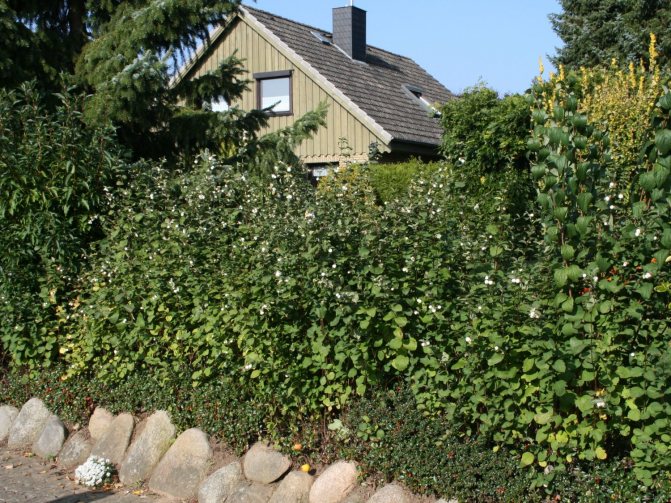

Spirea
There are about 90 different species of spirea, it blooms beautifully in spring without causing much trouble. The height of the finished hedge is about 1.5 meters, it is thick, impassable for most animals. Any soil is acceptable for spirea, and falling varieties do not even need pruning. There are also species that preserve brightly colored foliage all year round. Popular types: Japanese, Arguta, Frobeli, Bumalda, Medium meadowsweet. Fencing is recommended in October, in sod-peat soil, initially abundant watering is required.
Boxwood
Boxwood or buxus is suitable for both freely growing fences and strict geometric shapes. It is easy to care for and can live up to 500 years. Frost-resistant species have green foliage, thermophilic ones - variegated. For planting in the ground, specimens aged 3-7 years are suitable, they are planted in a trench, from early May to October, a maximum of a month before the onset of cold weather. Watering is necessary only during dry periods; haircut is performed from spring to late autumn every 5-6 weeks. To obtain a rectangular hedge, a wooden frame is required. It is important to know that all parts of the boxwood are very poisonous, therefore children are not allowed to come near it.
Thuja Brabant and Smaragd
Thuja is an evergreen tree actively used in landscape design. An impenetrable high fence made of it will perfectly protect against dust, alien intrusions and excessive noise. Low-growing varieties are used for arranging curbs. Thuja Brabant for the winter becomes brown-brown, but at the same time it retains the opacity of the fence, during the season the tree adds up to 40 cm in height. The recommended age of seedlings for the formation of a hedge is over three years.Thuja Smaragd is green all year round, has a conical shape, but grows slowly. The fence made of it has a serrated top edge, which further complicates unwanted penetration into the site. Young plants need abundant watering, older ones are also not advisable to dry out.
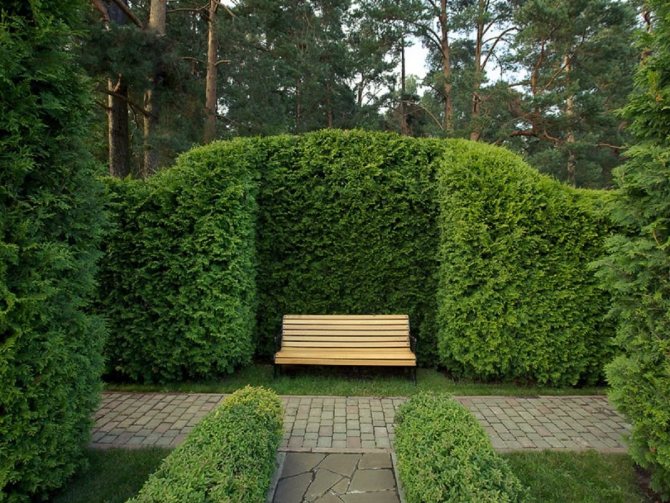

Forsythia
A hedge is formed from it in the fall, forsythia is very frost-hardy, blooms dazzling yellow, much earlier than others, before the first foliage appears. Forsythia prefers sunny areas where there are no strong winds or drafts. To create fences, varieties with the most dense crown are selected. The plant looks good in mixed plantings, for lush flowering it is fertilized twice a year. Watering is necessary in especially dry seasons, pruning - as needed, but frozen, old branches must be cut off.
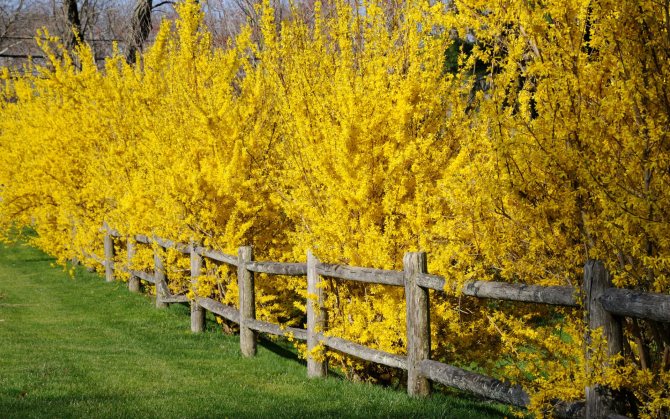

Chubushnik
Chubushnik or garden jasmine is an incredibly fragrant plant; during flowering it emits a sweetish, intoxicating smell. Chubushnik fences are graceful, but lush, reaching 2.7 meters, flowers of a white-cream shade. It is recommended to plant in sunny places with fertile soil, which should not be swampy. The formation of the planting is possible from two-three-year-old seedlings or cuttings, in autumn or spring. Rejuvenating pruning is necessary every two years - then the flowering will be as lush as possible, thinning is necessary in spring, annual feeding before the beginning of the growing season.
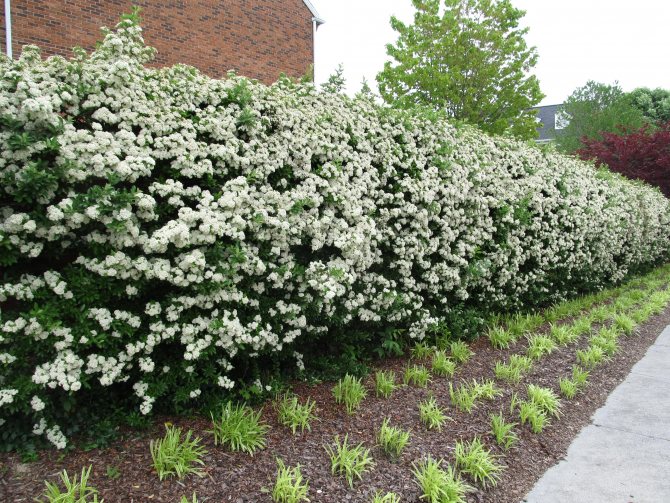

Mulberry
Of all the types of mulberry, white or black is most often used to create living walls, but there are about 18 species in total. It is resistant to cold weather, can live up to 200 years, has a spreading crown, incredibly tasty berries of white or black-purple color. Planting is preferable on well-drained loamy soils, preferably on the southern side, the soil must be mulched so that the roots do not freeze. Sanitary pruning is done in winter, shaping is done on one and a half meter boles. For abundant fruiting, annual fertilization is necessary.
Rose hip
The rosehip hedge comes out very prickly, smells delicious during the flowering period, after which it gives useful, edible fruits. Designers often use "wild" rosehip - it is more unpretentious. Popular varieties: wrinkled, gray-gray, Scottish rose, fragrant. The planting is formed from three-year-old seedlings with developed roots, but the use of cuttings is also acceptable. So that the root system does not grow throughout the entire site, it is limited by pieces of slate dug to a depth of 50-60 cm. Young specimens are watered every four days, adults - only in drought, fertilization is done every spring.
Distinctive features of the shrub
The plant, whose homeland is the Siberian forests, has perfectly taken root almost throughout the entire territory of our country. Derain white, or svidina, is unpretentious and well tolerates any whims of nature: it can withstand severe frosts, scorching heat and temperature changes. He has adapted to the conditions of the urban environment, the air of which contains a large amount of harmful compounds.
White derain is a fast-growing deciduous shrub, its height ranges from 1 to 3 m. It blooms in small inflorescences of a cream or white shade twice a year: in May-June and August-September. In autumn, along with recently blossoming flowers, small round berries appear on it. Almost all varieties have erect shoots of bright red color.
Beautiful and unpretentious turf
Honeysuckle and main varieties
Edible honeysuckle
There are a huge number of edible varieties of this wonderful berry for every taste. The berry has a slight bitterness. In the mid 50s, breeders worked to develop varieties without bitterness. They did it. Now you can enjoy the sweetest berry varieties. These include the varieties Sibiryachka, Nymph, Souvenir, Omega, Roxana, Silginka and Altair.It is worth mentioning that honeysuckle is the very first shrub to bear fruit. And only after a few weeks you can enjoy the fruits of other garden plants.
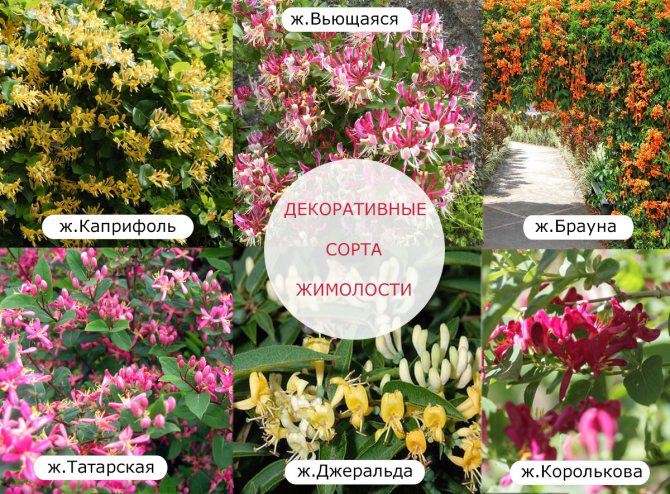

Decorative varieties of honeysuckle have gained well-deserved popularity for their beauty and incredibly delicate and enchanting aroma. Especially in the evening hours, the garden where this stunning shrub grows is filled with an incredible fragrance. I would like to stay outside longer to enjoy the scent on summer evenings.
The most suitable varieties for creating a hedge are: Tatarskaya honeysuckle, Gerald, Korolkov, Brown and of course Caprifol.
But the ornamental shrub has one feature to be aware of. Its fruits are poisonous. Therefore, you should be careful.
Most popular varieties
Elegantissima is a very common variety of white deren. It has a luxurious lush crown of green leaves, framed by a white border, acquiring a light pink hue by the beginning of autumn. The elegantissim deer hedge is great for fencing the site. Planted along the fence, it creates a dense three-meter wall.
Elegantissim deren fence
Derain aurea has very wide leaves that change color depending on the season. Brown-burgundy young leaves gradually become pale yellow, and in the fall they acquire a reddish tint.
The Siberian variety is a low shrub up to one and a half meters high with bright green foliage. Coral-red bark gives it a special charm, which looks amazing against a snow-white background. The photo shows how a deer hedge can beautify the site in the winter.
Siberian variegat grows up to two meters and pleases the eye with its multicolored colors all year round. In spring, the plant releases purple-red young shoots, in summer it is covered with a delicate green-white crown. The hedge looks especially impressive in autumn, when the bushes turn red and purple.
Unlike other varieties, the crown of deren spet remains unchanged throughout the growing season. The yellow border framing the green leaves gives the plant a luxurious golden hue. A hedge made from turf of this variety will create a festive mood and become a bright spot at the summer cottage.
View of deren in winter
Requirements for green hedges
In order for the hedge to turn out to be unpretentious and decorative at the same time, you first need to pick up a photo of the plants, study the descriptions of the groups, make possible combinations, and only then start planting. Gardeners prefer to purchase fast-growing varieties so that in a couple of years the green fence will acquire a presentable appearance.
Advantages of green fences:
- Shrub fences should easily replace the fence, hiding the backyard from prying eyes.
- If the fence is old, densely planted crops will hide it.
- With the help of overgrown plantings, it is easy to divide the site into zones.
- Lush undergrowth protects the garden from the scorching sun and restrains drafts, a dense linear planting drowns out extraneous noise.
Hydrangea with boxwood - Saplings with intensive growth rates are used to decorate the walls of buildings, including gazebos. The shoots create the necessary partial shade and beautifully braid the buildings.
- A fence in the form of an overgrown plant makes the territory more presentable, the abundance of greenery allows you to purify the air.
- Flowering crops serve as excellent honey plants.
Plants are selected very different: conifers, deciduous, decorative, flowering and even fruit. Perennials that are resistant to adverse conditions are suitable, plus they should have a dense crown, uniform growth, resistance to pests and frosty winters.
How to plant deren bushes
White derain can be planted on any soil, provided that there is enough moisture in it. The shrub loves the sun, but it also feels good in the shade. The optimal planting time is early spring or late autumn, but before the onset of frost.It is best to purchase 4-year-old seedlings, they take root well and give a lot of shoots.
The planting material is old enough, so for each it is advisable to make a separate planting hole with a depth of about 60 cm. Seedlings of high varieties are planted at a distance of 2–2.5 m from each other, low ones - 1–1.5 m. Specimens whose age does not exceed 3 -x years old, can be planted in a trench. Its width should be 60–80 cm; a distance of 1–2 m is left between the bushes.
Before planting, a little organic fertilizer is added to the pit: humus or compost, then a seedling is placed and sprinkled with soil. You cannot immediately fill up the whole earth, you need to do this gradually in small portions, each time compacting the soil.
Planting live fencing
What are the types of living fences?
If you want to plant a beautiful living fence, try to determine in advance the place of planting, what size the plants should be and what shape they should be.
All hedges can be divided into three types:
- living wall - all trees will be more than two meters;
- medium hedge - live plantations will be about 1-2 meters high;
- small curb hedges - plant height ranges from half a meter to one meter.
Basic rules for caring for a hedge
Unpretentious sod does not need special care. He will delight with his multicolored colors, even if left completely unattended. But in order to give the bushes an aesthetic shape and form the same beautiful and neat hedgerow from white turf, as in the photo, the plant needs periodic pruning.
Watering and feeding shrubs
Daily watering is necessary only for young seedlings after planting. An adult plant in cold weather can do without water for a long time. But if the summer is dry, the shrubs should be watered about 2-3 times a month. In the morning or evening hours, 2.5 buckets of water should be poured under the roots.
There is no particular need to fertilize the soil. But in order to improve the appearance of the shrub and accelerate its growth, the dogwood can be fed twice a year. In the spring, mineral fertilizers are applied (140 g per bush), and in the summer - organic (6 kg of humus or compost per plant).
Turf fence
Hedge functions
A "live" fence is not just a beautiful, multifunctional fence, but also an original element of landscape design, designed to harmoniously complement the existing architectural ensemble. Such plantings have been used by humans for many centuries, and the methods of caring for them are constantly being improved.
The living fence not only looks good, being a source of pride for the owner, but also perfectly cleans the air from toxic substances inevitably present in the air near large cities, gives a shadow, which is important for both humans and animals, prevents soil erosion, erosion, overdrying it. Curly species are allowed to "crawl" along the old shabby fence, masking in an original way, giving an aesthetic appearance.
Previously, fruit plants used for food were planted as a living fence, but the yield with excessively dense plantings is very small.
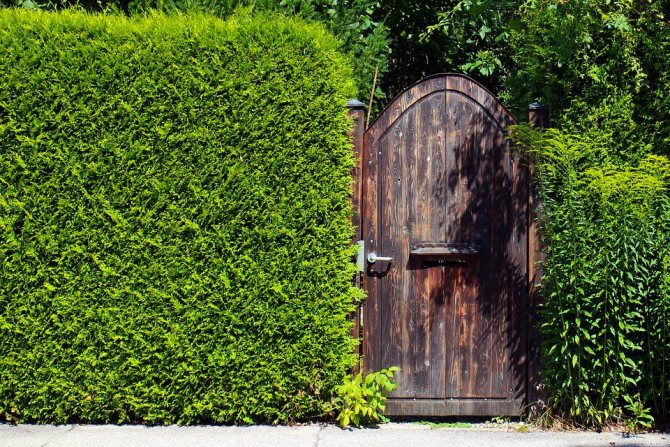

What is the secret of the bush?
In culture, white dogwood is described as a hedge that changes its dress several times a year. After all, as soon as the heat subsides, the period of rains will begin, the cooling of the dogwood will heal in a new way. The first impression of him is an ordinary, unremarkable bush. All the greenery that surrounded the branches becomes completely different - they transform into burning orange leaves. They can also be purple, red, and even purple. It all depends on the variety that was planted. And in winter you can observe the wonderful coral-colored bark of the branches. The decorative value of this shrub is very high due to these qualities of reincarnation in different periods of the year.
Among gardeners, white dogwood or cornus alba remains the leader among gardeners. Very tall bushes, sometimes reaching three meters, cannot be unnoticed.It blooms twice a year - after 2-3 years of growth, the first flowering period will begin in early summer and may be repeated in September. In addition to flowers, fruits will appear. So, this plant is also used as a fruitful one. Some species are known for their delicious, sweet and sour red fruits.
Honeysuckle and beneficial properties
Honeysuckle is rich in micro and macro elements that have a beneficial effect on the human body. Moderate consumption of berries has a positive effect on the cardiovascular system. Increases the overall tone of the body, resulting in improved immunity. It has a positive effect on cerebral circulation, which helps to improve memory and mental performance. Also, the vitamins contained in the berry improve visual acuity.
There are a number of contraindications. Allergies may appear, in the form of skin rashes. Also, honeysuckle has a diuretic effect. Do not eat for diabetics.
In any case, you shouldn't eat unlimited amounts of honeysuckle. It is good to know when to stop in everything.
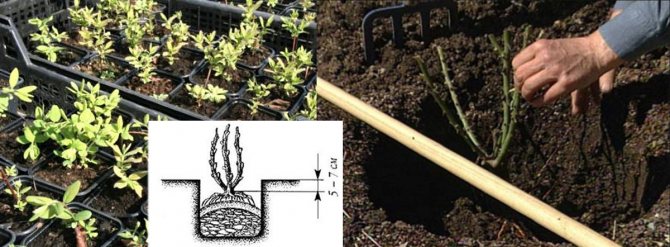

Before planting honeysuckle, you need to prepare the soil. It is worth considering the fact that the plant is light-loving, therefore, sunny places are selected for planting it. The main thing is not to plant shrubs in closed pits. Basically, any soil will do. Fertilizers must be added to the hole, mixing them with the top layer of mail and after planting the seedling, water the hole well. Saplings are best purchased in nurseries. Choose several different varieties. This will have a good effect on the level of self-pollination of plants. The optimum seedling height ranges from 20 cm to 1 meter. You should not choose lower and higher, as they may not take root. It is desirable that the seedlings have an open root system, so they take root better.
Kalina gordovina - not affected by aphids
Viburnum vulgaris is a bright shrub with bunches of coral berries and lobed foliage, similar to maple leaves, is well known to people even far from gardening. But for creating a hedge, another type of this plant is much more suitable - viburnum gordovina.
Kalina gordovina is great for creating a hedge in partial shade.
This variety is a dense shrub up to four meters high with a dense but compact crown. This species differs from the viburnum ordinary in large pubescent leaves covered with white hairs, which give the impression of velvety.
Viburnum gordovina blooms profusely in May-June with white inflorescences-caps, after which attractive bright red and black berries are tied on the bushes. The main advantage of this culture over the common viburnum is that this shrub is not affected by aphids.
Planting a hedge from viburnum gordovina and care
In order to create a hedge, 2-3-year-old plants are planted at a distance of 30-40 centimeters from each other. Kalina gordovina loves fertile, well-moistened soils. Therefore, in a drought, she will need watering, even after the plants have taken root well.
In the second year, at the beginning of summer, the young growth can be cut by 2-3 nodes to enhance the branching of the bush. Further, the formation of a hedge from the gordovina viburnum will consist in removing too thick old shoots. In young stems, only the tops are pinched.
This type of viburnum is most suitable for creating a free-growing screen, and should be pruned to a minimum. For plants with such large leaves and thick stems, a strong overcutting will not look very harmonious. The total life expectancy of the shrub is long (about 60 years), so such a hedge will perform its function for many years.
Pros of the gordovina viburnum hedge
- grows well both in the shade and partial shade;
- viburnum gordovina is unpretentious in care and is more drought-resistant than ordinary viburnum;
- the shrub has an edible sweetish fruit;
- during the fruiting period, this viburnum is very decorative, its glossy berries are red at first, and then they turn black;
- the fruits of this viburnum are edible, they are sweet and juicy in taste.
Cons of gordovina viburnum hedge
- in comparison with other shrubs, it reacts poorly to drought and needs watering;
- shrub grows relatively slowly;
- the plant will feel bad on peat, sandy and podzolic soils.
After the flowering of the Hordovina viburnum, attractive bright red and black berries are tied on the bushes.
What is the derain?
This bush is deciduous, from the dogwood family. The turf usually grows up to three meters in height, and its chic crown, with careful care, can stretch as much as five meters. It is widespread in Siberia, Ukraine and Belarus. Green leaves have one distinguishing feature - a whitish bloom around the edges, and the flowers are in the shape of an umbrella (see photo). As for the fruits, they look like gray peas. The most important advantage of deren is its good susceptibility to climate and resistance to external stimuli. Thanks to all this, he has lived for more than a quarter of a century.
Forsythia oval
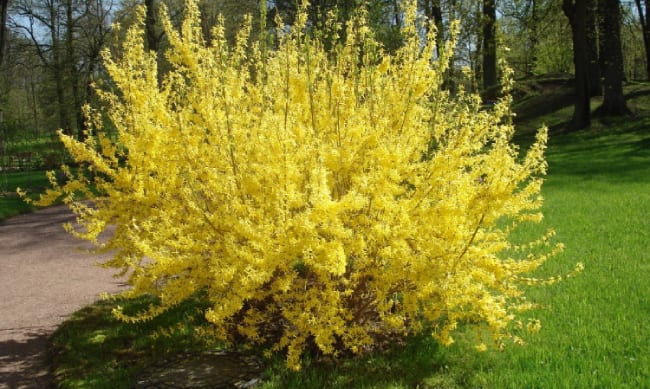

Forsythia oval
A compact bush with a height of 1-3 meters, which is also called "golden bell". The plant is "weeping" because of the branches falling down. Other features of forsythia:
- the flowers are golden yellow, bell-shaped in shape;
- the fruit is a box with winged seeds;
- foliage is bright green, and by autumn they are colored with a purple tint.
All types of this plant for hedges are demanding on soil fertility. Forsythia takes root in dry soil with low / neutral acidity, so it should be planted in a calcareous substrate. The site should be sunlit and protected from the winds.
Pruning is done in spring and summer. The first is needed to remove old, dried, frozen branches. In the summer, after flowering, simply extra shoots are removed - this will preserve the decorative appearance of forsythia. Watering is required only in dry weather, but no more than twice a month. The optimal water consumption is 10–12 liters per bush.
Forsythia fence
You need to feed forsythia three times during the entire season. Both organic and mineral fertilizers are used:
- In early spring, the trunk circle is covered with a five-centimeter layer of rotted manure. It should be placed close, but not close to the bush. This will become both mulch and top dressing at the same time.
- April is the time for the introduction of mineral fertilizers (60-70 g of nitroammofoska per 1 m2).
- In the summer, when forsythia has grown flower buds, it is fed with Kemiroi-universal (100-120 g per 1 m2).
Crown mock
Crown mock
South European tall shrub, growing up to 3 meters. Resistant to smoke, gas pollution and frost, withstanding up to -25 ° C. External features of the crown mock-orange:
- Flowers of a creamy tint, collected in a brush of 5-7 pieces.
- The fruit is a box with three to five sides, filled with small seeds.
- Leaves are oval, with sparse teeth at the edges. Their upper part is naked, the lower part is pubescent.
The crown mock-orange is planted in areas open to the sun. The shade is not suitable for the shrub - the flowers bloom small, the shoots are stretched out more. Optimal soil composition:
- humus - 1 part;
- sand - 2 parts;
- leaf land - 3 parts;
- drainage (if the soil has poor water permeability).
Scheme for trimming the common mock-orange
Pruning is carried out in the fall (sanitary) and in the spring (sanitary with formative). It is necessary to water the mock-orange every week with 2-3 buckets of water, and during the flowering period this is done daily. Moreover, it is also desirable to mulch the soil around the bush using peat or sawdust in a layer of 5-6 cm. Top dressing is carried out only in spring:
- Each plant is fertilized with a bucket of a mixture of manure and water (1:10).
- Mineral dressings are applied only from the fourth year of life.One bush is watered with a solution of 10 liters of water, 30 g of superphosphate, 15 g of urea and 15 g of potassium sulphide.
Plant characteristic
One of the most suitable hedge plants on the site is honeysuckle. Such a hedge made of honeysuckle, unlike other plants that cannot withstand frost, will delight with its greenery from early spring to late autumn.
Honeysuckle is a bush that reaches a height of 6 meters, has increased decorative qualities. A hedge can be made from several varieties of honeysuckle, or from one.
The result will be a blooming living fence of different colors and shades. The most suitable for such a fence is the Kaprifol honeysuckle variety, since it best withstands the climatic conditions of northern latitudes. Honeysuckle grows best in sunny areas with fertile and moist soil, but can also grow in shaded areas.
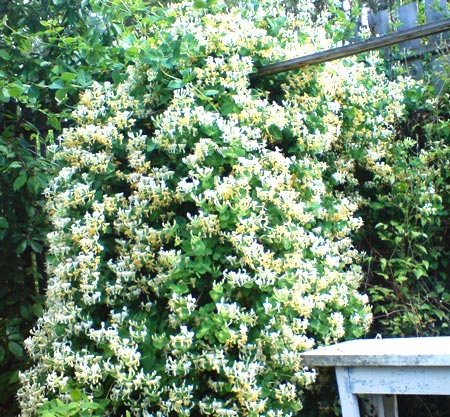

It looks like a honeysuckle variety Caprifol
This species is distinguished by dense foliage and gorgeous flowers. After the honeysuckle has faded, berries appear on it, which are quite suitable for eating. Absolutely all varieties of honeysuckle grow very quickly. The bushes are dense, which allows you to quickly create living bush fences from it, decoratively and tastefully decorated.
Yellow acacia
There are a lot of species of this plant, it can be both a shrub and a five-meter tree. But in this case, it will be about a shrub that will feel great in any climate. He tolerates a haircut well, he quickly recovers even after cutting "under a stump". Each bush produces abundant growth. Propagated by seeds only.
Characteristics of a hedge turf
Derain is Siberian by origin, therefore it perfectly tolerates most of the weather. Frost, drought, hot periods rarely have a big impact, damaging the plant. The temperature drops, typical of most regions, are well tolerated. Grown by the wild in Siberian forests, the dogwood adapts, perceiving the urban environment, adjusting its life cycles in the stale, stuffy, dusty air.
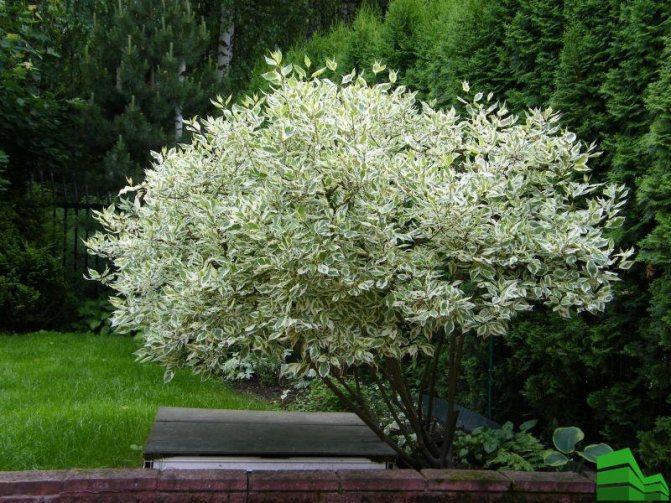

Turf shrub
The shrub is medium in size, less than three meters tall, and is characterized by a fairly rapid growth. There are two flowering periods: May-June, August-September. After the September bloom, red berries appear.
Pruning honeysuckle
Like all cultivated plants, the shrub must be thinned from time to time. This is necessary for the ripening of more juicy and large fruits. And it is also important that the plant fits harmoniously into the existing landscape. Therefore, seasonal sanitary and molding pruning is carried out.
Sanitary pruning
Sanitary pruning of plants is carried out in late autumn or early spring. There is a general methodology that is recommended to be followed.
All branches of the bush are examined first. Fortunately, this is easy to do, because the plant is not covered with foliage. Determine the skeletal branches that will be worked with a pruner, garden shears, or a hand or electric hedge trimmer. The skeletal branch is easy to spot. As a rule, it is longer and larger than the rest. Then they start pruning in accordance with some principles:
- we shorten the skeletal branches to the required height;
- we cut off all dry and broken fragments;
- we remove the processes growing deeper into the bush, which thicken the honeysuckle;
- if the goal is to rejuvenate the bush, then all branches are cut from the ground under a small stump.
Form trimming
Formative plant pruning, in contrast to sanitary pruning, is carried out when the shrubs are covered with foliage. The task of trimming is to give the most suitable aesthetic shape. In this case, the object is a green crown, which is worked with the help of improvised tools. To save time and effort, it is recommended to use an electric garden brush cutter.
How to care?
Experienced gardeners say that the best time for planting is spring, that period when the snow has melted and the soil becomes loose. The distance when planting bushes should be equal to one meter between them (if this is not a future hedge), since this plant loves and values its personal space very much. Derain also loves an abundance of sunlight and warmth, but will not refuse shady areas. Elegatissima requires watering in the first months of its life, especially during the hottest days of the year. Fertilizers should not be neglected. If you add humus to the soil, you can see the shrub grow faster. But this is not absolutely necessary. Is that in the spring a little fertilize. Weeding the soil under the bushes is also a mandatory procedure, since weeds can damage the growth and development of the turf in every possible way. Also, experienced gardeners recommend resorting to the mulching procedure. With its help, the soil will always be loose, and unwanted guests will appear less and less. As with any plant on the site, it is imperative to approach the lawn with a pruner in order to cut off old branches. By pruning them, you will give the shrub a new shape and stimulate the growth of new shoots.
This shrub has iron immunity against external stimuli, it cannot be overcome by diseases or garden pests. Only during the period when the dogwood is still only a seedling should it be treated with insecticides.
Common privet
An unpretentious shrub that grows up to 2 meters in height. Drought-resistant and the most frost-resistant of all types of privet. External features of the plant:
- flowers are snow-white with a yellow core, collected in dense panicles;
- fruits - small black berries (in some varieties of privet they are yellow or green);
- the leaves are dark green above and light below.
Common privet
A nutritious, moderately moist soil is suitable for privet. The optimum acidity of the soil is weak or neutral. Clay, dryness and high pH are not suitable for shrubs. It is better to plant common privet in a sunny place, although it will adapt to partial shade.
These hedge bushes are only watered in dry conditions. One season is 3-4 irrigations with a consumption of 30-40 liters of water for each plant. Top dressing is carried out before summer:
- organic matter (humus or compost) is spread along the hedge;
- then this layer is sprinkled with superphosphate granules at the rate of 10 g per meter;
- the resulting mass is embedded shallowly into the soil.
It is necessary to cut the privet hedges in May and August. Spring pruning relieves the bush of broken, frozen and diseased branches. In the summer, the plant is shaped. Moreover, for the middle lane, it is recommended to shorten the privet up to 50 cm in height. This will save the shoots from frostbite in winter when the hedge is covered with snow.
Benefit
For many years, white turf has been planted as decoration and hedges in public places, so it is the best candidate for landscaping and air purification. This shrub is not afraid of secateurs, after which it continues to grow beautifully. Now it can be found not only in public places, but also on the plots of private houses and dachas. Another plus of deren is the ability to fit into compositions with other plants, it will look especially advantageous in autumn, when the plants begin to transform and dazzle. Quite advantageously, the dogwood looks like a bush in the center of the lawn (see the photo on the Internet). Sod is often planted near sheds and any unremarkable objects.
Deren's description
(Cornus
) belongs to the family
Cornelian
(
Cornaceae
). Not all of its types (
C. capitata
,
C. controversa
,
C. florida
,
C. kousa
,
C. Nuttallii
) are adapted to our climate. It is better to grow them where there are no such long and frosty winters as in central Russia. When buying planting material, you should pay attention to this.I was once let down by the desire to buy a wonderful bush of an unknown species to me,
derena blooming
(
C. florida
). Its branches turned black immediately after the first frosty winter. In our harsh climate, several winter-hardy species of turf grow well and bear fruit. The most popular of these is
derain white
(
Cornus alba
). It is also called white svidina, or white dogwood. Among the people, white deren is known as
blushed
.
During the season, there are two peaks of flowering: in May - June and in August - September. At this time, the bush is decorated with numerous corymbose inflorescences of white or cream flowers. Individual inflorescences appear throughout the summer. It is worth taking a close look at the deren flower. This is a real tiny laboratory in which everything is thought out to the smallest detail. Crawling and flying insects work in it. They are responsible for cross-pollination. When the supply of nectar runs out, the nectar disc at the base of the column turns red. Pollinating insects receive a signal: the flower no longer needs their services. For self-pollination, a fallback is provided, in which the stamens of one flower come into contact with neighboring flowers of the same inflorescence.
Derain white
(
C. alba
) Is the most popular species, adapted to the conditions of our climatic zone. It is originally a large shrub with branchy flexible branches of red, brown or brownish-red color. In nature, the redhead can be found along the sides of the roads, on the edges of the forest, along the shores of lakes and rivers. Among the bushes there are beauties with dazzling red bark. In autumn and winter, such bushes are clearly visible from afar.
The species sod looks beautiful at any time of the year. Admires the plastic of the interlacing of the branches. White rounded fruits (berries up to 8 mm in diameter) at the end of summer adorn the shrub along with the recently appeared flowers. Very little time passes, and the foliage changes color to autumn. It becomes bronze-crimson, orange or burgundy.
Why hedges are valued in gardening
Hedges are becoming more and more popular every year. The owners of summer cottages and adjoining plots are increasingly using green spaces along with or even instead of traditional fences. And this is not surprising, because a green screen has many advantages over traditional fencing.
A hedge is not only a designation of the boundaries of the site, protection of the garden from winds, road noise and the looks of curious passers-by. It is also an integral part of landscape compositions, a uniform background for variegated flower beds and expressive groups of deciduous and coniferous plants.
In addition, green curtains can unobtrusively decorate unattractive outbuildings and perfectly cope with the task of separating functional areas with picturesque lines, smoothing corners, and sometimes visually changing the configuration of the garden.
Aesthetics
Often this shrub is planted in public places and botanical gardens - this can be seen in many photos. He can live with flowers as well as with other trees. Derain will always look great all year round, as can be seen from the photo. Every season he has something to charm those around him. In addition, you will always hear the singing of birds, as birds love to feast on the fruits of this charming bush. It should be noted that the fruits of this plant attract not only birds. The gardeners themselves note the aesthetic value of the turf during the period when it begins to bear fruit.
What is a house with a gorgeous garden? First of all - the face of the owner, an indicator of his taste and beauty. On the site you can place all kinds of plants - ampelous or huge bushes. And today we will talk about such, at first glance, nondescript shrub, like white dogwood. Why nondescript? The white turf shrub in summer is no different from most shrubs - dense branches with green leaves and small white flowers.However, all of its decorative charm and potential is revealed with the onset of autumn. The hedge formed from it will delight the eye not only in spring and summer, but also in late autumn. The correct ones are described in detail in this article. Well, you can also see the white turf in the photo, illustrating all the charm of the shrub:
This is a genus of the decorative family "Kizilovs". In Latin, Cornus (this is its real name) is translated as "horn". And it was obtained for a reason - the branches of the plant are very strong, like the horns of animals.
Bubble-leaf Vine-leaved
Bubble-leaf Vine-leaved
Strongly branching, frost-resistant and unpretentious shrub, reaching 3 meters in height. The crown is lush, dense and has a spherical shape. Other features of the vesicle are as follows:
- The flowers are white with a pink tint.
- The fruits are bubble-shaped leaflets. The original color is light green, but when ripe it changes to red.
- The leaves are green above and lighter below. Moreover, in the lower part, they are sometimes pubescent.
A hardy puzereplodnik is undemanding to the composition of the soil. The optimum soil for it is loose and fertile loam that does not contain lime. The shrub takes root even in partial shade, but then its foliage fades. Therefore, it is better to plant the plant in a sunny area.
Blooming bubble
Watering is required only during hot and dry periods. It is held twice a week (early in the morning or after sunset). The normal volume for one bush is 40 liters, and water must be poured strictly at the root. It is important that the soil in the near-stem circle is still mulched with a layer of peat 5–8 cm. Top dressing is carried out in the off-season:
- Spring - a solution is used, the composition and proportions of which per 1 bush are as follows: 10 liters of water, half a liter of mullein, 1 tbsp. l. ammonium nitrate, 1 tbsp. l. urea.
- Autumn - each plant is fertilized with a solution of 10 liters of water and 2 tablespoons of nitroammofoska.
Trimming the hedge from the bladder is done twice a year - in spring and summer. Adult shrubs are additionally rejuvenated:
- Spring (before the buds swell) - remove broken, diseased and frozen branches / shoots. At the same time, you can trim the bush so as to give it the desired shape.
- Autumn (during leaf fall) - only formative pruning.
- Rejuvenation - pruning on a stump. It is carried out at the age of 6-7 years of the life of the bush.
Yew berry
An evergreen coniferous tree known for its longevity and decorative appearance. The maximum height is from 17 to 27 meters. This is the most shade-tolerant coniferous plant, all parts of it are poisonous. The external data of the yew berry are as follows:
- The crown is dense, spreading, ovoid-cylindrical in shape.
- The needles are flat, the arrangement is spiral (on the lateral branches - two-row). The needles are dark green and shiny, below - matte, yellowish.
- The trunk is covered with reddish gray bark.
- The seeds are kept in bright red seedbeds.
Yew berry
The first 2-3 years of life, the yew must be protected from drafts. It can take root even in scarce land, but light, fertile and drained soil is better suited. Soil with a high acid and moisture content is strictly unacceptable. Optimal Yew Substrate:
- peat (2 parts);
- sand (2 parts);
- turf / leafy land (3 parts);
The amount of watering is 1–1.5 buckets of water for each tree. The frequency depends on the age of the plant:
- young (up to 3 years old) - monthly.
- adults (3 years and older) - monthly, only during drought.
- sprinkling of the crown - carried out in the evenings at any age, but also only in the heat.
The trunk circle is mulched with a layer of peat, needles or sawdust (thickness - 8-10 cm). Fertilizers are applied annually using nitroammofoska (50-70 g / m2) or Kemiru-universal (100 g / m2). The yew hedge is pruned in early April before the buds open. Dry, diseased, frostbitten branches are removed immediately. Formative pruning is carried out only for an adult plant, since the yew grows slowly.
Euonymus
A shrub especially respected by landscape designers.
In summer, with its openwork crown, it will create an impenetrable lush carpet, and in autumn it will “bloom” with red, orange, yellow, and purple leaves.
In May, euonymus flowers bloom - bright pink and white. In late autumn, before severe frosts, the branches of the bush are decorated with bright fruits.
Shaped hedge options with photos of fences
If you decide to grow a hedge with your own hands, then put a little soul into this process, and the result will not be long in coming. In order to inspire our readers, we offer a small photo gallery of already created living fences.
And if you still have questions for the author of this article or want to share your own experience in creating green hedges, leave your ideas below in the comments.
List of the most famous varieties:
- Elegantissima - branches of red color, flowers of a creamy color in the shape of an umbrella and leaves with a bloom around the edges. Siberica - practically do not differ from the first grade, with the exception of foliage in the autumn. Aurea - ocher foliage with white fruits. Shpeta - yellow-green foliage with white fruits. Kesselrings are red branches, white fruits and reddish foliage. This variety is one of the most persistent. Elegantissima is a beautiful shrub with a white frame on the leaves. It is impossible not to pay attention to the flowers and fruits, and in winter it creates a great contrast to the whiteness of the winter period.
Spirea - lush bloom, minimal care
Spirea is a flowering shrub. In the month of May, the plant dresses in an openwork snow-white outfit of small fragrant flowers with the smell of honey. Spireas blooming in spring, as a rule, are tall plants (up to 2.5 meters), having a spreading bush and medium-sized leaves.
The less the spirea is cut, the more abundantly it blooms.
With a regular haircut, the green curtains from the spirea are quite dense, like real walls. Nevertheless, the plantings have an elegant appearance and, thanks to the small foliage, look delicate and weightless.
Planting a spirea hedge and care
Spireas are planted at the age of two with an interval of 40-50 cm. The formation of a hedge can be started already in the first year. Features of cutting spirea depend on the belonging of plants to the group of spring-flowering or summer-flowering plants.
In varieties of spirits that bloom in spring, unlike summer ones, flower buds are formed only on last year's shoots, so they can be cut only at the end of flowering. Cutting in early spring will prevent the plants from blooming this season.
By the way, a spirea hedge, which is cut too often and intensively, usually blooms very little or does not bloom at all. Therefore, it is important here to choose what is more important for the gardener - a strict form or white fragrant flowers.
The first haircut is carried out in June after the plants have completely faded. With formative pruning, they cut quite intensively, giving the green wall the necessary shape. Further, in the middle of summer, correction is carried out as the shoots grow back (several times per season).
The first haircut of summer-flowering spirits is carried out in the spring (April-May). In culture, spirea is unpretentious and does not require any special care.
The best varieties of spirea for hedges in partial shade
Most often, spireas are planted in the sun, but some species will do well in partial shade. First of all, this applies to varieties with green leaves blooming in spring (spirea agruta, wangutta, Thunberg, trilobal, gray etc.).
Many types of spirea, when formed, quickly lose their natural arched shape and grow vertically upward. From summer-flowering spirits, tall species can also be selected for the role of a hedge (spirea billard, willow, Douglas), blooming with pink flowers.
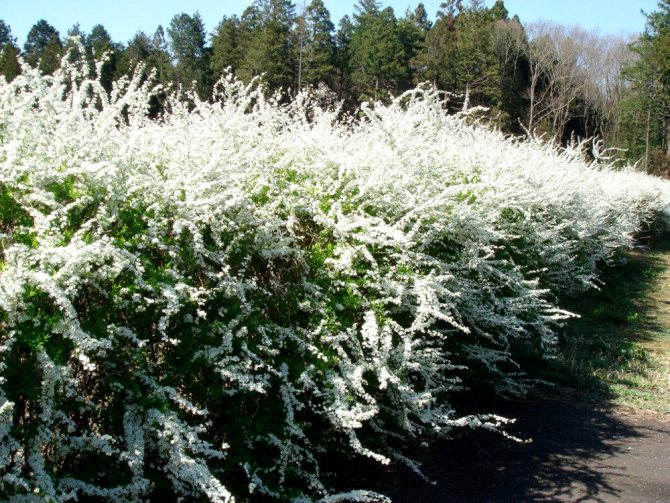

Spirea Tunberg grows well in partial shade.
Pros of a spirea hedge
- undemanding in relation to the type and fertility of the soil;
- subject to moderate haircuts, blooms profusely in spring or mid-summer;
- faded inflorescences do not affect the appearance;
- tolerates haircuts well and holds its shape after trimming;
- due to the fact that the spirea branches are very thin, the places of the cuts are almost invisible;
- openwork crown looks good in winter, covered with frost;
- winter-hardy, drought-resistant, practically does not get sick and is rarely affected by insects.
Cons of spirea hedges
- with frequent or untimely pruning, spring-flowering spireas do not bloom too abundantly;
- irregular cutting of the hedge leads to the exposure of the lower part of the bush, and the spirea begins to look unkempt;
- to maintain shape, sometimes it is necessary to cut the hedge "on a stump" in order to rejuvenate (this procedure is carried out no more than once every 10 years).
What is better to make a hedge from - recommendations of our editorial office
In fact, this question is purely individual. Someone wants to completely hide their house from prying eyes, while someone prefers only a hint of a fence. In our country, “better” is most often replaced by the word “cheaper”. But this approach is fundamentally wrong. Living fences, planted wisely, will more than pay off in a short time, while a metal fence will not add aesthetics and will cost more. Not to mention more modern materials - fiberglass and other expensive materials.
If the territory of your site is small, then it is easier and more effective to make a single-breed hedge. In large gardens, especially those with a simple arrangement, it is best to try to create living structures from different plants. Each of which will add its colors to your site: in the fall with a change of foliage, in the spring with abundant flowering. For mixed hedges, you can use various varieties of lilac, mock orange, viburnum, forsythia, spirea, barberries, maples, felt cherries, dogwood, cinquefoil and others.
What to cook with honeysuckle
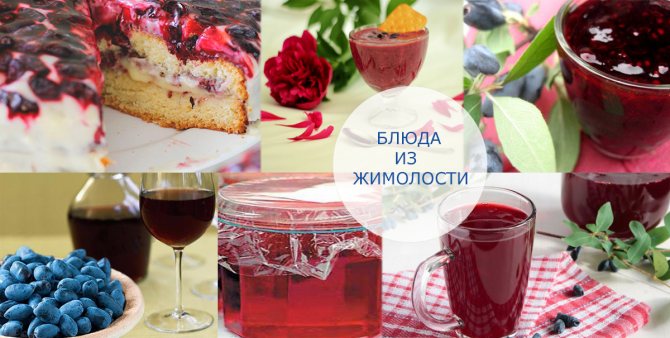

Edible varieties of honeysuckle are used to prepare both delicious, but familiar, and very original dishes. Here is some of them:
- Bakery products... It is pleasant to please your household and guests with a freshly baked honeysuckle pie. Make delicious cakes or bake pies.
- Compotes... An excellent drink, especially in hot summer weather, is freshly brewed compote and honeysuckle jelly. It will perfectly quench your thirst and fill you with energy, thanks to the beneficial substances contained in the berries.
- Preserves, jams and confiture. It is especially pleasant in the autumn-winter period, wrapped in a soft blanket, enjoying honeysuckle jam with hot tea and thinking about good things.
- Jelly... And juicy jelly, prepared in unusual molds, will especially delight kids with its rich color and pleasant taste.
- Smoothie... An appetizing refreshing cocktail for breakfast will be enjoyed by both older and younger household members.
- Home wine. An excellent solution for processing a large amount of freshly harvested honeysuckle is homemade wine, which is not a shame to serve on the table on holidays.
Thanks for reading my blog. I am sure that you have learned useful and interesting information about the magnificent honeysuckle shrub. And in the next article I will talk about the shrub, from which hedges are also built. It's about barberry.
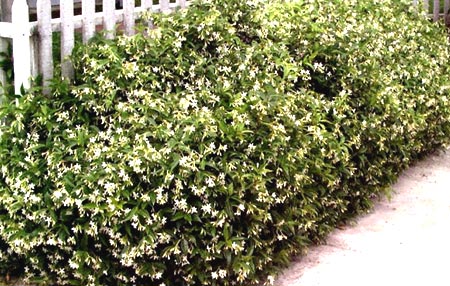

Each person wants to make and plan their site or summer cottage special. That is why recently hedges from completely different plants have become so popular. After all, green living walls are very practical and beautiful.
An example of a honeysuckle hedge
Hawthorn
The main advantage is simplicity. It easily takes root in a new place. Looks smart during spring flowering, summer ripening of berries and autumn multicolored leaves.
It can reach 6 meters in height. The branches are covered with long thorns, which is the main reason for using it for an outdoor green fence. Uninvited guests cannot overcome such an obstacle.
And the hawthorn berries, known for their healing properties, are useful in a home medicine cabinet.
Formation of the crown of the white deren
Derain is a real find for gardeners. You can work wonders with him. A wide range of decorative forms and varieties of white deren allows you to use this shrub to decorate the site one hundred percent. Here are some tips for a gardener when picking up a pruner or saw.
In order to form the backbone of the shrub, old branches that have lost their luster are cut down. Remove excess growth, branches that are broken and ugly sticking out to the sides. In summer, by pruning, they correct the shape and limit the growth of branches in an undesirable direction. To maintain the shape of the bush has to be regularly cut. It can be carried out almost all year round, excluding a short period of active sap flow. Of course, winter is not the best time for crown formation, although it is not forbidden to cut off a certain number of "extra" branches. Svidina tolerates pruning painlessly. Shoots grow back quickly, which allows you to correct mistakes made during the previous formation, or give the bush a new shape.
Column.
On our site there is a four-meter column made of species svidina (with green leaves and scarlet bark). This shrub grew from a cuttings shoot. If you look closely at those deren bushes that grow on the banks of rivers, in the undergrowth, on the slopes of ravines, along roads and in many other places, you can see that they are all slightly different. Among them there are shrubs with very bright red bark. Even a single rooted shoot of such a shrub eventually turns into a beautiful bush. The species turf has a drive for unrestrained growth. If I left it to myself, then there would be no room left on the site, not only for other plants, but also for us. To prevent this from happening, it is necessary to restrain the growth of a viable shrub.
I leave only the strong branches directed upwards and some of the overgrowth, so that the bush takes on the appearance of a column. It is important not to overdo it here, as too high a narrow "column" can collapse. It keeps on powerful old shoots that have not yet lost the luster of the bark. The backbone of the bush is a good support. The column is filled with young shoots and shoots.
Arc.
From the long branches of the species deren, bent into an arc, beautiful green arches are obtained. I sometimes create such an arch in the summer, bending those tall young shoots of the "column" that are 1.5 m from the fence. The arch between the bush and the two-meter fence not only decorates the site, but also gives shade on a sultry summer day. This option of using a tall turf can be beaten by decorating the area with arches between neighboring bushes or between a bush and some kind of structure, a fence.
Hemisphere.
The sod looks beautiful, shaped like a hemisphere. To do this, every year in early spring or autumn, two-year and three-year shoots are cut off at a level of 10 cm from the ground. This technique stimulates the early emergence of new shoots and rejuvenates the shrub. In addition, low pruning (especially of old bushes) at the very beginning of spring is needed so that the shrub does not bare from below and has a lush crown. Some winter-hardy variegated svidins, for example, the low (about 1.5 m) variety "Ivory Halo", are simply created to form them into a hemisphere. Without pruning, the shrub becomes bare from below over time and looks worse than the formed one.
Ball, cube and other shapes.
We have two spectacular turf bushes on the site. One -
Gochaulti
(
Gouchaultii
). It is a medium-sized bushy shrub with green leaves bordered by an uneven wide yellow line with a faint pink tinge. Another -
Elegantissima
(
Elegantissima
). Every year, with the help of large pruning shears, they alternately turn into a cube or a ball. This allows not only to decorate the site with living "figures", but also inhibits the uncontrolled growth of shrubs. You can beautifully shape the shape of a bush variety
Siberica Variegata
(
Sibirica variegata
). At the end of the season, all of its foliage turns purple-red.Several domestic firms offer seeds of white deren
Carantus
... According to the picture and the description printed on the seed bags, it is very similar to Siberica Variegata.
Popular Derain White Elegantissima = Argenteomarginata
(
Elegantissima = Argenteomarginata
) - up to three meters high - has foliage decorated with a wide, uneven white stripe. The variety is also suitable for creating spectacular shrubs in the form of a ball or cube.
Stamp forms.
Derain white, formed into one trunk, can be turned into a low tree, "panicle" or ball "on a leg". For this, some one shoot is selected, which is intended to become a stem. The rest of the shoots are cut at the root. The stem is regularly cleaned of buds and emerging twigs. It is better to tie it to a support. To form the crown, the top and all new upper branches are shortened. The directions of the buds at the ends are taken into account in order to create a crown of a certain shape with geometric accuracy. It is necessary to monitor the stem all the time. For this, the buds are blinded and the shoots are cut off. White variegated dogwood is ideal for growing in standard form
Ivory Halo
(
Ivory Halo
).
Hedges.
When creating hedges from svidina, they regularly cut out dried and broken branches, thin out, adjust the width and height of the hedge, and correct the line. Spectacular "fences" are obtained from svidina
Elegantissima
(
Elegantissima
), a tall (up to three meters) winter-hardy shrub with white-bordered bluish leaves and red bark of branches (in winter). Looks good hedge from
Aurea Elegantissima
(
Aurea elegantissima
) with yellow-variegated leaves. Without regular pruning, a beautiful and neat hedge from any turf turns into impenetrable thickets over time, capturing new spaces.
A number of ornamental varieties of Dahl White Derain Siberia
(
Sibirica
,
Koralle
,
Westonbirt
). It grows in damp places, more often along rivers in Siberia, Manchuria and northern China. In autumn, the light green leaves turn purple-red or dark purple. It is a tall (up to 3 meters) deciduous shrub with strong, long, erect shoots. There are always a lot of overgrowths and creeping side shoots around the bush. In spring, the bright red bark turns slightly green, and before the onset of winter it turns red and shines again. The dark green leaves underneath are light bluish in color. Creamy white flowers are collected in corymbose inflorescences up to 5 cm in diameter. They appear in May - early June. Flowering continues for a long time. Later, the shrub is decorated with white pea fruits with a slightly bluish tinge. The hedge made from this turf needs regular pruning. Without it, the bush will lose the scarlet color of the branches in the winter. For a hedge of medium height, I can recommend
Siberica Variegata
(
Sibirica variegata
) Is a dense compact bush with large leaves, decorated with a wide white uneven border.
Ideal for hedges that require minimal corrective trimming, turf white Shpet
, or svidina
Spati
, dogwood
Shpet
(
Spaethii
). It is a bush about 2.5 meters high with leaves bordered along the perimeter with a golden yellow wide strip, and with a reddish-brown bark. Derain white Shpeta is the most "yellow" variety, in which the blossoming leaves seem to be bronze. Later, a wide golden stripe and spots appear. Some leaves remain completely yellow. The Spati svidina hedge is suitable for a sunny location and needs good watering. Unfortunately, in the northern regions in winter, it can partially freeze. Instead, it is not uncommon for varieties to sell a smaller (1.5 m tall) variety.
Gauchaulty
(
Gauchaultii
,
Froebelii
) with slightly drooping leaves. They have a narrower and less "golden" bordering strip. This kind of re-grading in a tall hedge can cause unsightly failures. Lovers of yellow will also like white wood.
Aurea
(
Aurea
) with monochromatic pale yellow leaves.The height of the bush (1.5 - 2 m) is also suitable for a hedge.
White dogwood feels great in a hedge Kesselrings
(
Kesselringi
) 2 - 3 m high. It is necessary not only to regularly shorten the lower branches, but also to ensure that the upper line of its fast-growing shoots is even. The bright green leaves turn purple in the fall.
Natural shape.
Most hobby gardeners are faced with the fact that they do not have the time (energy or desire) to engage in regular trimming of the lawn, which is necessary to maintain a given shape. For lovers of the natural form of trees and shrubs, you can advise a fairly winter-hardy
Argenteomarginate
(
Argenteomarginata
) with light green leaves, decorated with creamy white spots and a border. From a distance the bush looks silvery. The hand does not rise to cut its beautiful branches. In this case, gentle pruning is suitable, in which only damaged shoots are removed and the dimensions of the bush are contained. Derain white
Aurea
(a medium-sized shrub up to two meters high with a bushy crown) also looks great in its natural form. Its leaves are so much yellow that they appear golden in a sunny or slightly shaded place.
Variety Kesselrings
(
Kesselringii
) also looks great in its natural form. This tall, dense shrub sometimes has to be thinned out in order to better see the intense color of the dark brown-red bark. Most of the shoots are directed upwards. The lower shoots form a “skirt” that the mower can handle. To rejuvenate the bush, it is cut "on a stump". A tall, single bush can beautify the site.
It grows for a while without pruning and the variety Gauchaulty
(
Gauchaultii
) up to 1.5 meters high. His freedom ends as soon as he begins to press against neighboring plants and interferes with the passage.

